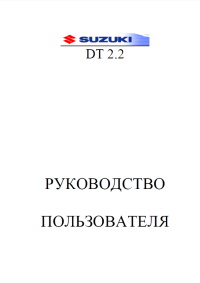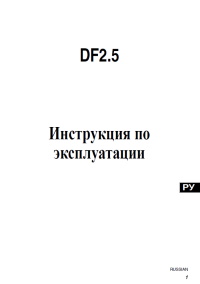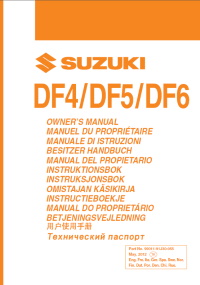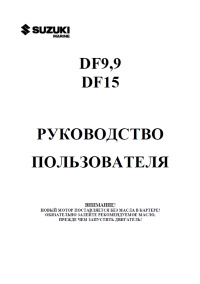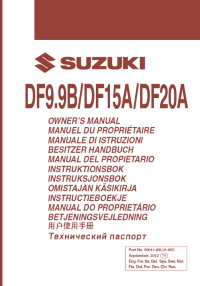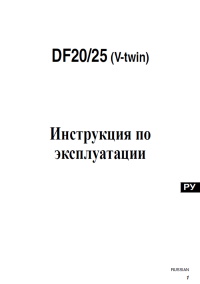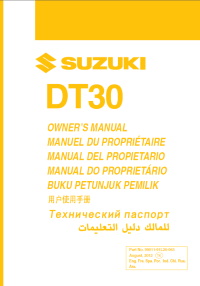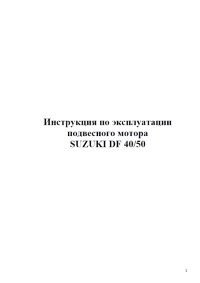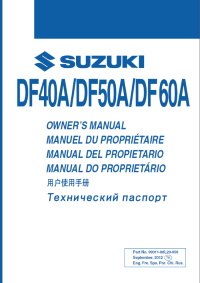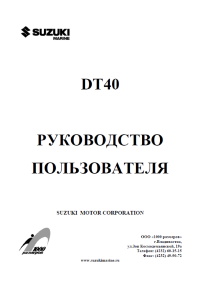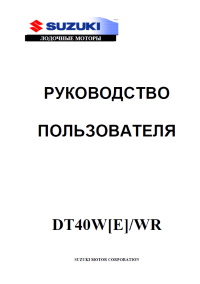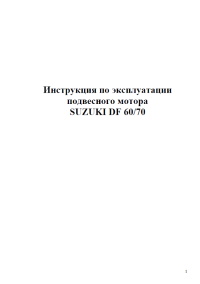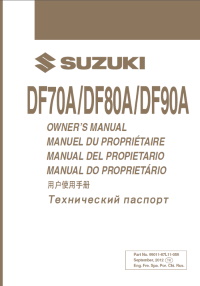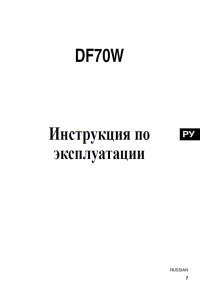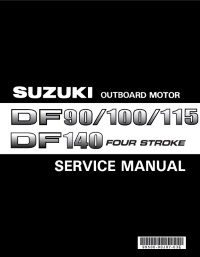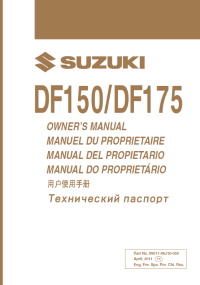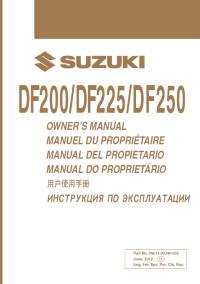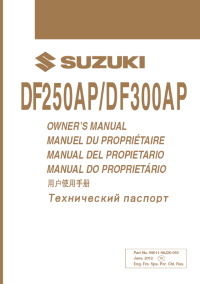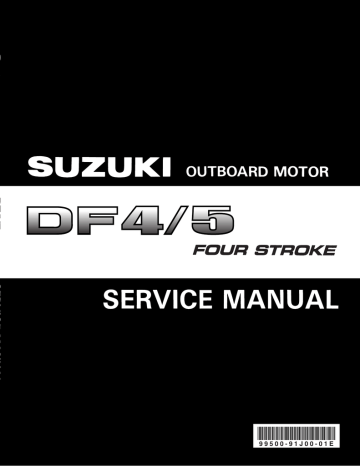Условные обозначения моделей лодочных моторов Honda
Все двигатели Honda — четырехтактные
Условные обозначения:
Буквы в обозначении мотора, например: BF 10 D2 S H S E
- BF – обозначение всех лодочных моторов производства Honda;
- 10 – мощность мотора в л.с.;
- D2 – семейство ( D ) и модельный год (2 = 2002г.);
- S, X, L – высота транца (короткий, длинный, сверхдлинный соответственно);
- H, R – тип управления (дистанционное управление или румпельная рукоятка);
Модели с дистанционным управлением оборудованы электростартером и выходом для зарядки аккумулятора 12В–6А. Все остальные типы оборудованы выходом для зарядки аккумулятора 12В-12А.
Эта позиция может отсутствовать:
- S – электрический стартер, система подзарядки аккумулятора 12В-12А (без электростартера 12В-6А);
- G – газовый подъём мотора;
- E – регион, для которого предназначен мотор ( E = Европа).
Расшифровка буквенных обозначений в лодочных моторах HONDA
BF — обозначение всех 4-х тактных лодочных моторов производства Honda
20 — мощность мотора в л.с.
A2 — семейство (A) и модельный год (2=2002г)
S — высота транца короткий 381 мм.(BF-20 D3 SRTE)
L — высота транца, длинный 508 мм.
X — высота транца, сверхдлинный, 635 мм.
E — регион, для которого предназначен мотор (E-европа);
B — система подзарядки аккумулятора (может не указываться)
H — управление с румпеля
R — дистанционное управление
S — электростартер (если S в последних 2-х буквах BF20D3 LHSU)
D — ручной запуск
G — подъем газовым цилиндром
T — электрогидроподъем
Руководство по эксплуатации и техническому обслуживанию подвесного лодочного мотора Suzuki модели DT2.2.
- Год издания: —
- Страниц: 26
- Формат: PDF
- Размер: 1,0 Mb
Сборник руководств по эксплуатации и техническому обслуживанию + технический паспорт подвесного лодочного мотора Suzuki модели DF2.5.
- Год издания: —
- Страниц: 34+46
- Формат: PDF
- Размер: 2,3 Mb
Сборник руководств по эксплуатации и техническому обслуживанию подвесных лодочных моторов Suzuki моделей DF4, DF5 и DF6.
- Год издания: —
- Страниц: 39+50
- Формат: PDF
- Размер: 4,2 Mb
Руководство по эксплуатации и техническому обслуживанию подвесных лодочных моторов Suzuki моделей DF8A и DF9.9A.
- Год издания: —
- Страниц: 66
- Формат: PDF
- Размер: 2,0 Mb
Руководство по эксплуатации и техническому обслуживанию подвесных лодочных моторов Suzuki моделей FD9.9 и DF15.
- Год издания: —
- Страниц: 41
- Формат: PDF
- Размер: 1,7 Mb
Сборник руководств по эксплуатации и техническому обслуживанию подвесных лодочных моторов Suzuki моделей DT9.9-DT15.
- Год издания: —
- Страниц: 38+51
- Формат: PDF
- Размер: 3,0 Mb
Руководство по эксплуатации и техническому обслуживанию подвесных лодочных моторов Suzuki моделей DF9.9B, DF15A и DF20A.
- Год издания: —
- Страниц: 70
- Формат: PDF
- Размер: 2,4 Mb
Руководство по эксплуатации и техническому обслуживанию подвесных лодочных моторов Suzuki моделей DF20 и DF25.
- Год издания: —
- Страниц: 50
- Формат: PDF
- Размер: 1,5 Mb
Сборник руководств по эксплуатации и техническому обслуживанию подвесного лодочного мотора Suzuki модели DT30.
- Год издания: —
- Страниц: 40+56
- Формат: PDF
- Размер: 4,0 Mb
Руководство по эксплуатации и техническому обслуживанию подвесных лодочных моторов Suzuki моделей DF40 и DF50.
- Год издания: —
- Страниц: 36
- Формат: PDF
- Размер: 1,2 Mb
Сборник руководств по эксплуатации и техническому обслуживанию подвесных лодочных моторов Suzuki моделей DF40A, DF50A и DF60A.
- Год издания: —
- Страниц: 31+72
- Формат: PDF
- Размер: 22,5 Mb
Руководство по эксплуатации и техническому обслуживанию подвесного лодочного мотора Suzuki модели DT40.
- Год издания: —
- Страниц: 37
- Формат: PDF
- Размер: 2,7 Mb
Руководство по эксплуатации и техническому обслуживанию подвесных лодочных моторов Suzuki моделей DT40W, DT40WE и DT40WR.
- Год издания: —
- Страниц: 22
- Формат: PDF
- Размер: 2,6 Mb
Руководство по эксплуатации и техническому обслуживанию подвесного лодочного мотора Suzuki модели DT40WK.
- Год издания: —
- Страниц: 24
- Формат: PDF
- Размер: 1,3 Mb
Руководство по эксплуатации и техническому обслуживанию подвесного лодочного мотора Suzuki модели DF50W.
- Год издания: —
- Страниц: 49
- Формат: PDF
- Размер: 1,2 Mb
Руководство по эксплуатации и техническому обслуживанию подвесных лодочных моторов Suzuki моделей DF60 и DF70.
- Год издания: —
- Страниц: 36
- Формат: PDF
- Размер: 1,2 Mb
Сборник руководств по эксплуатации и техническому обслуживанию подвесных лодочных моторов Suzuki моделей DF70A, DF80A и DF90A.
- Год издания: —
- Страниц: 45+69
- Формат: PDF
- Размер: 8,1 Mb
Руководство по эксплуатации и техническому обслуживанию подвесного лодочного мотора Suzuki модели DF70W.
- Год издания: —
- Страниц: 49
- Формат: PDF
- Размер: 1,2 Mb
Руководство по эксплуатации и техническому обслуживанию подвесных лодочных моторов Suzuki моделей DF90, DF115 и DF140.
- Год издания: —
- Страниц: 41
- Формат: PDF
- Размер: 1,4 Mb
Руководство на английском языке по техническому обслуживанию и ремонту подвесных лодочных моторов Suzuki моделей DF90, DF100, DF115 и DF140.
- Год издания: —
- Страниц: 616
- Формат: PDF
- Размер: 42,9 Mb
Руководство по эксплуатации и техническому обслуживанию подвесных лодочных моторов Suzuki моделей DF115W и DF140W.
- Год издания: —
- Страниц: 49
- Формат: PDF
- Размер: 1,3 Mb
Сборник руководств по эксплуатации и техническому обслуживанию подвесных лодочных моторов Suzuki моделей DF150 и DF175.
- Год издания: —
- Страниц: 43+59
- Формат: PDF
- Размер: 2,6 Mb
Руководство по эксплуатации и техническому обслуживанию подвесных лодочных моторов Suzuki моделей DF200, DF225 и DF250.
- Год издания: —
- Страниц: 61
- Формат: PDF
- Размер: 1,6 Mb
Руководство по эксплуатации и техническому обслуживанию подвесных лодочных моторов Suzuki моделей DF200W, DF225W и DF250.
- Год издания: —
- Страниц: 52
- Формат: PDF
- Размер: 1,4 Mb
Руководство по эксплуатации и техническому обслуживанию подвесных лодочных моторов Suzuki моделей DF250AP и DF300AP.
- Год издания: —
- Страниц: 78
- Формат: PDF
- Размер: 2,0 Mb
Руководство по эксплуатации и техническому обслуживанию подвесного лодочного мотора Suzuki модели DF300.
- Год издания: —
- Страниц: 51
- Формат: PDF
- Размер: 1,3 Mb
На этой странице вы найдете инструкции к лодочным моторам Suzuki на русском языке. Для просмотра используйте Adobe Acrobat Reader.
Suzuki DF2.5
c 2006 года
Suzuki DF4
c 2004 по 2015 год
SUZUKI DF4A
c 2016 года
Suzuki DF5
c 2004 по 2015 год
Suzuki DF5A
c 2016 года
Suzuki DF6
c 2004 по 2015 год
Suzuki DF6A
c 2016 года
Suzuki DF8A
c 2009 по 2014 год
Suzuki DF8A
c 2014 года
Suzuki DF9.9A
c 2009 по 2014 год
Suzuki DF9.9A
c 2014 года
Suzuki DF9.9
c 1994 по 2012 год
Suzuki DF9.9B
c 2013 года
Suzuki DF15
c 1994 по 2012 год
Suzuki DF15A
c 2013 года
Suzuki DF20A
c 2013 года
Suzuki DF25 V-twin
c 2005 по 2014 год
Suzuki DF25A
c 2015 года
Suzuki DF30A
c 2015 года
Suzuki DF40WT
c 1998 по 2012 год
Suzuki DF40A
c 2013 года
Suzuki DF50WT
c 1998 по 2012 год
Suzuki DF50A
c 2013 года
Suzuki DF50AV
c 2014 года
Suzuki DF60A
c 2013 года
Suzuki DF60AV
c 2014 года
Suzuki DF60WT
c 1997 по 2008 год
Suzuki DF70WT
c 1997 по 2008 год
Suzuki DF70A
c 2008 года
Suzuki DF80A
c 2008 года
Suzuki DF90WT
c 2000 по 2008 год
Suzuki DF90A
c 2008 года
Suzuki DF100WT
c 2000 по 2012 год
Suzuki DF100A
c 2012 года
Suzuki DF100B
c 2018 года
Suzuki DF115WT
c 2000 по 2012 год
Suzuki DF115A
c 2012 года
Suzuki DF140WT
c 2000 по 2012 год
Suzuki DF140A
c 2012 года
Suzuki DF150T
c 2005 по 2020 год
Suzuki DF150TG
c 2014 по 2018 год
Suzuki DF150AT
c 2019 года
Suzuki DF150AP
c 2016 года
Suzuki DF175T
c 2005 по 2020 год
Suzuki DF175TG
c 2014 по 2018 год
Suzuki DF175AT
c 2019 года
Suzuki DF175AP
c 2016 года
Suzuki DF200T
c 2004 года
Suzuki DF200AT
c 2015 года
Suzuki DF200AP
c 2015 года
Suzuki DF225T
c 2004 года
Suzuki DF250T
c 2004 года
Suzuki DF250AP
c 2012 года
Suzuki DF300T
c 2006 по 2012 год
Suzuki DF300AP
c 2012 года
Suzuki DF300B
c 2019 года
Suzuki DF325A
c 2018 года
Suzuki DF350A
c 2017 года
Инструкции к двухтактным подвесным моторам Suzuki
Suzuki DT2.2
c 2000 по 2005 год
Suzuki DT9.9
c 2004 по 2014 год
Suzuki DT9.9K
c 2004 по 2018 год
Suzuki DT9.9A
c 2014 года
Suzuki DT15
c 2004 по 2014 год
Suzuki DT15A
c 2014 года
Suzuki DT25K
c 2004 по 2018 год
Suzuki DT30
c 2004 года
SUZUKI DT40W
c 2004 года
Suzuki DT40WK
c 2004 года
Инструкции к приборам и аксессуарам
Дистанционное управление Suzuki NA27S
Бесключевая система запуска Suzuki KLS
Использование режима Troll Mode
Suzuki Modular Instrument System SMIS
Инструкции к Установочным комплектам
комплект для заряда АКБ Suzuki DF4A/5A/6A
КОМПЛЕКТ ДЛЯ ЗАРЯДА АКБ SUZUKI DF9.9B/15A/20A
КОМПЛЕКТ ДЛЯ ЗАРЯДА АКБ SUZUKI DF8A/9.9A
99500-91J00-01E
FOREWORD
This manual contains an introductory description on
SUZUKI Outboard motor DF4/5 and procedures for
the inspection, service and overhaul of its main components.
General knowledge information is not included.
Please read the GENERAL INFORMATION section to familiarize yourself with basic information
concerning this motor. Read and refer to the other
sections in this manual for information regarding proper inspection and service procedures.
This manual will help you better understand this outboard motor so that you may provide your customers with optimum and quick service.
• This manual has been prepared using the latest information available at the time of publication.
If a modification has been made since then,
differences may exist between the content of
this manual and the actual outboard motor.
• Illustrations in this manual are used to show
the basic principles of operation and work procedures and may not represent the actual outboard motor in exact detail.
• This manual is intended for use by technicians
who already possess the basic knowledge and
skills to service SUZUKI outboard motors.
Persons without such knowledge and skills
should not attempt to service an outboard engine by relying on this manual only.
Instead, please contact your nearby authorized SUZUKI outboard motor dealer.
GROUP INDEX
GENERAL INFORMATION
1
PERIODIC MAINTENANCE
2
IGNITION AND ELECTRICAL
3
FUEL SYSTEM
4
RECOIL STARTER
5
POWER UNIT
6
MID UNIT
7
LOWER UNIT
8
WIRE / HOSE ROUTING
9
!
Apprentice mechanics or do-it-yourself mechanics that don’t have the proper tools and
equipment may not be able to properly perform the services described in this manual.
Improper repair may result in injury to the
mechanic and may render the engine unsafe
for the boat operator and passengers.
NOTE:
This manual is compiled based on 2002 (K2) model.
Marine & Power Products Division
COPYRIGHT SUZUKI MOTOR CORPORATION 2001
HOW TO USE THIS MANUAL
TO LOCATE WHAT YOU ARE
LOOKING FOR:
1. The text of this manual is divided into sections.
2. The section titles are listed on the previous page
in a GROUP INDEX. Select the section needed
for reference.
3. Holding the manual as shown at the right will allow you to find the first page of the section easily.
4. The first page of each section lists a table of contents to easily locate the item and page you need.
COMPONENT PARTS AND IMPORTANT ITEM ILLUSTRATIONS
Under the name of each system or unit, an exploded view is provided with work instructions and other
service information such as the tightening torque, lubrication and locking agent points.
Example :
1 Nut (1)
2 Key (1)
3 Flywheel (1)
4 CDI & coil unit (1)
5 Spark plug cap (1)
6 Bolt (2)
NOTE:
Clean the flywheel and crankshaft
mating surfaces with cleaning solvent.
SYMBOL
Listed in the table below are the symbols indicating instructions and other important information necessary for proper servicing. Please note the definition for each symbol. You will find these symbols used
throughout this manual. Refer back to this table if you are not sure of any symbol(s) meanings.
SYMBOL
DEFINITION
SYMBOL
"
Torque control required.
Data beside it indicates specified
torque.
*
#
Apply oil. Use engine oil unless
$
Apply SUZUKI OUTBOARD
%
otherwise specified.
MOTOR GEAR OIL.
Apply SUZUKI SUPER GREASE “A”.
&
Apply SUZUKI WATER
'
Apply SUZUKI BOND “1104”.
(
Apply SUZUKI BOND “1207B”.
)
Apply SUZUKI SILICONE SEAL.
RESISTANT GREASE.
+
DEFINITION
Apply THREAD LOCK “1342”.
Apply THREAD LOCK SUPER
“1333B”.
,
Measure in DC voltage range.
-
Measure in resistance range.
.
Measure in continuity test range.
0
/
Use peak voltmeter
“Stevens CD-77”.
Use special tool.
GENERAL INFORMATION
1-1
GENERAL INFORMATION
1
CONTENTS
WARNING / CAUTION / NOTE ________________________________ 1- 2
GENERAL PRECAUTIONS__________________________________ 1- 2
IDENTIFICATION NUMBER LOCATION _______________________ 1- 4
FUEL AND OIL ____________________________________________ 1- 4
GASOLINE RECOMMENDATION ................................................................ 1- 4
ENGINE OIL ................................................................................................... 1- 4
ENGINE BREAK-IN ________________________________________ 1- 5
PROPELLERS ____________________________________________ 1- 6
SPECIFICATIONS _________________________________________ 1- 7
SERVICE DATA ___________________________________________ 1- 9
TIGHTENING TORQUE _____________________________________ 1-15
SPECIAL TOOLS __________________________________________ 1-17
MATERIALS REQUIRED ____________________________________ 1-19
1-2
GENERAL INFORMATION
WARNING / CAUTION / NOTE
Please read this manual and follow its instructions carefully. To emphasize special information, the symbol
and the words WARNING, CAUTION and NOTE have special meanings. Pay special attention to the messages highlighted by these signal words.
!
Indicates a potential hazard that could result in death or injury.
"
Indicates a potential hazard that could result in motor damage.
NOTE:
Indicates special information to make maintenance easier or instructions clearer.
Please note, however, that the warnings and cautions contained in this manual cannot possibly cover all
potential hazards relating to the servicing, or lack of servicing, of the outboard motor. In addition to the
WARNING and CAUTION stated, you must also use good judgement and observe basic mechanical safety
principles.
GENERAL PRECAUTIONS
!
• Proper service and repair procedures are important for the safety of the service mechanic
and the safety and reliability of the outboard motor.
• To avoid eye injury, always wear protective goggles when filing metals, working on a grinder,
or doing other work, which could cause flying material particles.
• When 2 or more persons work together, pay attention to the safety of each other.
• When it is necessary to run the outboard motor indoors, make sure that exhaust gas is
vented outdoors.
• When testing an outboard motor in the water and on a boat, ensure that the necessary
safety equipment is on board. Such equipment includes : flotation aids for each person, fire
extinguisher, distress signals, anchor, paddles, bilge pump, first-aid kit, emergency starter
rope, etc.
• When working with toxic or flammable materials, make sure that the area you work in is wellventilated and that you follow all of the material manufacturer’s instructions.
• Never use gasoline as a cleaning solvent.
• To avoid getting burned, do not touch the engine, engine oil or exhaust system during or
shortly after engine operation.
• Oil can be hazardous. Children and pets may be harmed from contact with oil. Keep new and
used oil away from children and pets. To minimize your exposure to oil, wear a long sleeve
shirt and moisture-proof gloves (such as dishwashing gloves) when changing oil. If oil contacts your skin, wash thoroughly with soap and water. Launder any clothing or rags if wet
with oil. Recycle or properly dispose of used oil.
• After servicing fuel, oil/engine cooling system and exhaust system, check all lines and fittings related to the system for leaks.
• Carefully adhere to the battery handling instructions laid out by the battery supplier.
GENERAL INFORMATION
1-3
"
• If parts replacement is necessary, replace the parts with Suzuki Genuine Parts or their equivalent.
• When removing parts that are to be reused, keep them arranged in an orderly manner so that
they may be reinstalled in the proper order and orientation.
• Be sure to use special tools when instructed.
• Make sure that all parts used in assembly are clean and also lubricated when specified.
• When use of a certain type of lubricant, bond, or sealant is specified, be sure to use the
specified type.
• When removing the battery, disconnect the negative cable first and then the positive cable.
When reconnecting the battery, connect the positive cable first and then the negative cable.
• When performing service to electrical parts, if the service procedures do not require using
battery power, disconnect the negative cable at the battery.
• Tighten cylinder head and case bolts and nuts, beginning with larger diameter and ending
with smaller diameter. Always tighten from inside to outside diagonally to the specified tightening torque.
• Whenever you remove oil seals, gaskets, packing, O-rings, locking washers, locking nuts,
cotter pins, circlips, and certain other parts as specified, always replace them with new. Also,
before installing these new parts, be sure to remove any left over material from the mating
surfaces.
• Never reuse a circlip. When installing a new circlip, take care not to expand the end gap
larger than required to slip the circlip over the shaft. After installing a circlip, always ensure
that it is completely seated in its groove and securely fitted.
• Use a torque wrench to tighten fasteners to the torque values when specified.
Remove grease or oil from screw / bolt threads unless a lubricant is specified.
• After assembly, check parts for tightness and operation.
• To protect the environment, do not unlawfully dispose of used motor oil, other fluids, and
batteries.
• To protect the Earth’s natural resources, properly dispose of used motor parts.
1-4
GENERAL INFORMATION
IDENTIFICATION NUMBER LOCATION
MODEL, PRE-FIX, SERIAL NUMBER
The MODEL, PRE-FIX and SERIAL NUMBER of the motor
are stamped on a plate attached to the clamp bracket.
Example
THAI SUZUKI MOTOR CO.,LTD.
MADE IN THAILAND FABRIQUE AU THAILANDE
ENGINE SERIAL NUMBER
A second engine serial number plate is pressed into a boss
on the sylinder block.
FUEL AND OIL
GASOLINE RECOMMENDATION
Suzuki highly recommends that you use alcohol - free unleaded gasoline with a minimum pump octane rating of 87
(R+M / 2 method) or 91 (Research method). However, blends
of unleaded gasoline and alcohol with equivalent octane content may be used.
Allowable maximum blend of a single additive (not combination) :
5% Methanol, 10% Ethanol, 15% MTBE
"
If leaded gasoline is used, engine damage may result. Use only unleaded gasoline.
ENGINE OIL
Use only oils that are rated SE, SF, SG, SH, or SJ under the
API (American Petroleum Institute) classification system.
The viscosity rating should be SAE 10W-40.
If an SAE 10W-40 motor oil is not available, select an alternative according to the chart at right.
GENERAL INFORMATION
ENGINE BREAK-IN
The first 10 hours are critically important to ensure correct
running of either a brand new motor or a motor that has
been reconditioned or rebuilt. How the motor is operated
during this time will have direct bearing on its life span and
long-term durability.
Break-in period : 10 hours
WARM-UP RECOMMENDATION
Allow sufficient idling time (more than 5 minutes) for the engine to warm up after cold engine starting.
THROTTLE RECOMMENDATION
NOTE:
Avoid maintaining a constant engine speed for an extended
period at any time during the engine break-in by varying the
throttle position occasionally.
1. FIRST 2 HOURS
For first 15 minutes, operate the engine in-gear at idling
speed.
During the remaining 1 hour and 45 minutes, operate
the engine in-gear at less than 1/2 (half) throttle (3000 r/
min).
NOTE:
The throttle may be briefly opened beyond the recommended
setting to plane the boat, but must be reduced to the recommended setting immediately after planing.
2. NEXT 1 HOUR
Operate the engine in-gear at less than 3/4 (three-quarter) throttle (4000 r/min).
3. LAST 7 HOURS
Operate the engine in-gear at desired engine speed.
However, do not operate continuously at full throttle for
more than 5 minutes.
1-5
1-6
GENERAL INFORMATION
PROPELLERS
An outboard motor is designed to develop its rated power
within a specified engine speed range. The maximum rated
power delivered by the DF4/5 models are shown below.
Recommended full
throttle speed range
DF4
4000 – 5000 r/min
DF5
4500 – 5500 r/min
If the standard propeller fails to meet the above requirement,
use another pitch propeller to hold the engine speed within
the range specified above.
Propeller selection chart
Blade
3
3
3
×
×
×
×
Diam. (in)
7-#
7-#
7-#
×
×
×
×
Pitch (in)
6
(C 600)
6-#
(C 610)
7
(C 700)
"
Installing a propeller with pitch either too high or
too low will cause incorrect maximum engine speed,
which may result in severe damage to the motor.
GENERAL INFORMATION
*SPECIFICATIONS
Item
* These specifications are subject to change without notice.
Unit
PRE-FIX
Data
DF4
DF5
00401F
00501F
DIMENSIONS & WEIGHT
Overall length (front to back)
mm (in)
554 (21.8) : with tiller handle raised
Overall width (side to side)
mm (in)
309 (12.2)
S
mm (in)
1064 (41.9)
L
mm (in)
1191 (46.9)
S
kg (Ib)
26 (55.1)
L
kg (Ib)
27 (57.3)
S
mm (inch type)
442 (15)
L
mm (inch type)
569 (20)
Overall height
Weight
(without engine oil)
Transom height
PERFORMANCE
Maximum output
kW (PS)
2.9 (4)
3.7(5)
Recommended operating range
r/min
4000 – 5000
4500 – 5500
Idle speed
r/min
1300 ± 50 (in-gear : approx : 1150)
POWERHEAD
Engine type
4-stroke. OHV
Number of cylinders
1
Bore
mm (in)
62.0 (2.44)
Stroke
mm (in)
46.0 (1.81)
3
Total displacement
cm (cu in.)
138 (8.4)
Compression ratio
:1
9.2
NGK
BPR6ES
Spark plug
Ignition system
Fuel supply system
SUZUKI PEI (Digital CDI)
Carburetor
Exhaust system
Above prop exhaust
Cooling system
Water cooled
Lubrication system
1-7
Wet sump by trochoid pump
Starting system
Manual
Choke system
Manual
Throttle control
Twist grip
1-8
GENERAL INFORMATION
Item
Data
Unit
DF4
DF5
FUEL & OIL
Suzuki highly recommends that you use alcohol-free unleaded gasoline with
a minimum pump octane rating of 87 ( R 2+ M method) or 91 (Research
method). However, blends of unleaded gasoline and alcohol with equivalent
octane content may be used.
Fuel
Fuel tank capacity
(Built-in tank)
L (US/Imp. gal)
1.5 (0.4/0.3)
API classification
Engine oil
SE, SF, SG, SH, SJ
Viscosity rating 10W-40
Engine oil amounts
SUZUKI Outboard Motor Gear Oil (SAE #90 hypoid gear oil)
Gear oil
Gearcase oil amounts
0.7 (0.74/0.62)
L (US/Imp. qt)
ml (US/Imp. oz)
190 (6.4/6.7)
BRACKET
Trim angle
Number of tilt pin position
Maximum tilt angle
4° – 20° (Shallow drive angle: 32°,45°)
Adjustable
5
degree
71° (from lowest tilt pin position)
LOWER UNIT
Reversing system
Transmission
Gear
Forward-Neutral-Reverse
Reduction system
Bevel gear
Gear ratio
Drive line impact protection
Propeller
12 : 23 (1.92)
Shear pin and cogged rubber bushing
Blade
3
3
3
× Diam. (in) × Pitch (in)
×
×
×
7#
7#
7#
×
×
×
6
(C 600)
6 # (C 610)
7
(C 700)
GENERAL INFORMATION
*SERVICE DATA
Item
*These service data are subject to change without notice.
Unit
Data
DF4
DF5
4000 – 5000
4500 – 5500
POWERHEAD
Recommended operating
range
r/min
Idle speed
r/min
1300 ± 50 (in-gear: approx. 1150)
kPa (kg/cm2. psi)
550 – 650 (5.5 – 6.5, 78 – 92)
*Cylinder compression
(with decompression system)
Engine oil
Engine oil amounts
Thermostat operating
temperature
API classification
SE, SF, SG, SH, SJ
Viscosity rating
SAE 10W-40
L (US/Imp. qt)
0.7 (0.74/0.62)
°C (°F)
48 – 52 (118 – 126)
* Figures shown are guidelines only, not absolute service limits.
CARBURETOR
Item
Type
1-9
Unit
MIKUNI
I.D mark
Data
DF4
DF5
BV22-14-1
BV22-14-2
91J00
91J10
Main jet
#
77.5
Pilot jet
#
35
Pilot screw
Turns open
2#±$
Float height
mm
14 ± 1
1-10
GENERAL INFORMATION
Item
Unit
Data
DF4
DF5
CYLINDER HEAD / CAMSHAFT
Cylinder head distortion
Limit
mm (in)
0.05 (0.002)
Cam height
STD
mm (in)
32.460 – 32.520 (1.2780 – 1.2803)
Limit
mm (in)
32.160 (1.2661)
STD
mm (in)
32.538 – 32.598 (1.2810 – 1.2834)
Limit
mm (in)
32.238 (1.2692)
STD
mm (in)
0.016 – 0.062 (0.0006 – 0.0024)
Limit
mm (in)
0.150 (0.0059)
STD
mm (in)
0.016 – 0.052 (0.0006 – 0.0020)
Limit
mm (in)
0.150 (0.0059)
IN
EX
Upper
Camshaft journal
oil clearance
Lower
Camshaft
holder inside
diameter
Upper
STD
mm (in)
15.000 – 15.028 (0.5906 – 0.5917)
Lower
STD
mm (in)
16.000 – 16.018 (0.6299 – 0.6306)
Camshaft
journal outside
diameter
Upper
STD
mm (in)
14.966 – 14.984 (0.5892 – 0.5899)
Lower
STD
mm (in)
15.966 – 15.984 (0.6286 – 0.6293)
GENERAL INFORMATION
Item
Unit
Data
DF4
DF5
VALVE / VALVE GUIDE
IN
mm (in)
24.0 (0.94)
EX
mm (in)
22.0 (0.87)
IN
STD
mm (in)
0.03 – 0.07 (0.001 – 0.003)
EX
STD
mm (in)
0.03 – 0.07 (0.001 – 0.003)
Valve diameter
Valve clearance
(Cold engine
condition)
Valve seat angle
Valve guide to
valve stem
clearance
IN
15°, 45°
EX
15°, 45°
STD
mm (in)
0.025 – 0.052 (0.0010 – 0.0020)
Limit
mm (in)
0.075 (0.0030)
STD
mm (in)
0.045 – 0.072 (0.0018 – 0.0028)
Limit
mm (in)
0.090 (0.0035)
IN
EX
Valve guide
inside diameter
IN,EX
STD
mm (in)
5.500 – 5.512 (0.2165 – 0.2170)
Valve guide
protrusion
IN,EX
STD
mm (in)
11.0 (0.43)
IN
STD
mm (in)
5.460 – 5.475 (0.2150 – 0.2156)
EX
STD
mm (in)
5.440 – 5.455 (0.2142 – 0.2148)
Valve stem
deflection
IN,EX
Limit
mm (in)
0.35 (0.014)
Valve stem runout
IN,EX
Limit
mm (in)
0.05 (0.002)
Valve head
radial runout
IN,EX
Limit
mm (in)
0.08 (0.003)
Valve head
thickness
STD
mm (in)
1.0 (0.04)
IN,EX
Limit
mm (in)
0.5 (0.02)
IN
STD
mm (in)
0.8 – 1.0 (0.03 – 0.04)
EX
STD
mm (in)
1.0 – 1.2 (0.04 – 0.05)
Valve stem
outside diameter
Valve seat
contact width
Valve spring free
length
STD
mm (in)
29.5 (1.16)
Limit
mm (in)
28.3 (1.11)
Valve spring tension
STD
N (kg, Ibs)
139 – 159 (13.9 – 15.9, 30.6 – 35.1) for 19.3 mm (0.76 in)
Limit
N (kg, Ibs)
127 (12.7, 28.0) for 19.3 mm (0.76 in)
1-11
1-12
GENERAL INFORMATION
Item
Unit
Data
DF4
DF5
CYLINDER / PISTON / PISTON RING
Cylinder distortion
Limit
mm (in)
0.05 (0.002)
Piston to cylinder
clearance
STD
mm (in)
0.010 – 0.040 (0.0004 – 0.0016)
Limit
mm (in)
0.100 (0.0039)
Cylinder bore
STD
mm (in)
62.000 – 62.015 (2.4409 – 2.4415)
mm (in)
35 (1.4) from cylinder top surface
mm (in)
61.975 – 61.990 (2.4400 – 2.4406)
mm (in)
14 (0.6) from piston skirt end.
Limit
mm (in)
0.100 (0.0039)
STD
mm (in)
0.20 – 0.35 (0.008 – 0.014)
Limit
mm (in)
0.70 (0.028)
STD
mm (in)
0.35 – 0.50 (0.014 – 0.020)
Limit
mm (in)
1.00 (0.039)
STD
mm (in)
Approx. 8.5 (0.33)
Limit
mm (in)
6.8 (0.27)
STD
mm (in)
0.03 – 0.07 (0.001 – 0.003)
Limit
mm (in)
0.12 (0.005)
STD
mm (in)
1.22 – 1.24 (0.048 – 0.049)
STD
mm (in)
2.51 – 2.53 (0.099 – 0.100)
STD
mm (in)
1.17 – 1.19 (0.046 – 0.047)
STD
mm (in)
0.006 – 0.019 (0.0002 – 0.0007)
Limit
mm (in)
0.040 (0.0016)
STD
mm (in)
17.995 – 18.000 (0.7085 – 0.7087)
Limit
mm (in)
17.980 (0.7079)
STD
mm (in)
18.006 – 18.014 (0.7089 – 0.7092)
Limit
mm (in)
18.030 (0.7098)
STD
mm (in)
0.006 – 0.019 (0.0002 – 0.0007)
Limit
mm (in)
0.050 (0.0020)
Cylinder measuring position
STD
Piston skirt diameter
Piston measuring position
Cylinder bore wear
Piston ring
end gap
1st
2nd
Piston ring
free end gap
1st,
2nd
Piston ring to
groove
clearance
1st,
2nd
Piston ring
groove width
1st,
2nd
Oil
Piston ring
thickness
1st,
2nd
Pin clearance in
piston pin hole
Piston pin outside
diameter
Piston pin hole
diameter
Pin clearance in
conrod small end
GENERAL INFORMATION
Item
Unit
Data
DF4
DF5
CRANKSHAFT / CONROD
Conrod small end
inside diameter
STD
mm (in)
18.006 – 18.014 (0.7089 – 0.7092)
Limit
mm (in)
18.040 (0.7102)
Conrod big end oil
clearance
STD
mm (in)
0.015 – 0.035 (0.0006 – 0.0014)
Limit
mm (in)
0.080 (0.0031)
Conrod big end
inside diameter
STD
mm (in)
28.015 – 28.025 (1.1030 – 1.1033)
Crank pin outside
diameter
STD
mm (in)
27.990 – 28.000 (1.1020 – 1.1024)
Crank pin outside
diameter difference
(out-of-round and taper)
Limit
mm (in)
0.010 (0.0004)
Conrod big end side
clearance
STD
mm (in)
0.20 – 0.90 (0.008 – 0.0035)
Limit
mm (in)
1.20 (0.047)
Conrod big end width
STD
mm (in)
23.30 – 23.80 (0.917 – 0.937)
Crank pin width
STD
mm (in)
24.00 – 24.20 (0.945 – 0.953)
Crankshaft runout
Limit
mm (in)
0.05 (0.002)
Crankshaft lower
journal oil clearance
STD
mm (in)
0.020 – 0.062 (0.0008 – 0.0024)
Limit
mm (in)
0.100 (0.0039)
Crankcase lower
holder inside diameter
STD
mm (in)
25.000 – 25.021 (0.9843 – 0.9851)
Crankshaft lower
journal outside
diameter
STD
mm (in)
24.959 – 24.980 (0.9826 – 0.9835)
1-13
1-14
GENERAL INFORMATION
Item
Data
Unit
DF4
DF5
ELECTRICAL
Degrees at r/min
BTDC 6° – 26.5°
r/min
6000
Ignition coil resistance Secondary
kΩ at 20°C
8.4 – 12.4 [H.T.cord – pulser core]
Spark plug cap resistance
kΩ at 20°C
7.5 – 12.5
Battery charge coil resistance
(Optional part)
Ω at 20°C
0.6 – 1.0 [R – Y]
Watt
80
Type
NGK
BPR6ES
Gap
mm (in)
0.7 – 0.8 (0.028 – 0.031)
Ignition timing
Over revolution limiter
Battery charge coil output (12V)
(Optional part)
Standard spark plug
LOWER UNIT
Desige specification thickness for shim & washer
Pinion gear backup shim
mm (in)
2.0 (0.08)
Forward gear backup shim
mm (in)
1.2 (0.05)
Forward gear thrust washer
mm (in)
1.0 (0.04)
Reverse gear thrust washer
mm (in)
1.0 (0.04)
Reverse gear backup shim
mm (in)
0.8 (0.03)
Initial selection-shim adjustment may be required.
GENERAL INFORMATION
TIGHTENING TORQUE
Tightening Torque – Important Fasteners
TIGHTENING TORQUE
THREAD
DIAMETER
N.m
kg-m
Ib-ft
Cylinder head cover bolt
6 mm
8
0.8
6.0
Cylinder head bolt
8 mm
28
2.8
20.5
Crankcase bolt
6 mm
10
1.0
7.0
Conrod cap bolt
8 mm
21
2.1
15.0
Rocker arm pivot bolt
6 mm
10
1.0
7.0
Valve adjusting lock nut
6 mm
11
1.1
8.0
Intake manifold bolt
6 mm
10
1.0
7.0
CDI & coil unit mounting bolt
6 mm
10
1.0
7.0
Carburetor mounting bolt
6 mm
10
1.0
7.0
Fuel pump mounting bolt
6 mm
8
0.8
6.0
Fuel tank mounting bolt
6 mm
10
1.0
7.0
Flywheel nut
12 mm
50
5.0
36.0
Engine oil drain plug
10 mm
10
1.0
7.0
Power unit mounting bolt
6 mm
10
1.0
7.0
Bolt
8 mm
12
1.2
8.5
Nut
8 mm
17
1.7
12.5
Steering bracket cover bolt
6 mm
10
1.0
7.0
Swivel bracket cover bolt
6 mm
10
1.0
7.0
Gearcase nut / bolt
8 mm
17
1.7
12.5
Water pump case nut
6 mm
8
0.8
6.0
Shift rod guide plate bolt
6 mm
8
0.8
6.0
Rod connecting plate bolt
6 mm
11
1.1
8.0
Propeller shaft bearing housing bolt
6 mm
8
0.8
6.0
Clamp bracket shaft nut
10 mm
25
2.5
18.0
ITEM
Tiller handle pivot
1-15
1-16
GENERAL INFORMATION
Tightening torque – general bolt
NOTE:
These values are only applicable when torque for a general bolt is not listed in the “Important Fasteners”
table.
TYPE OF BOLT
(Conventional or “4” marked bolt)
(Stainless steel bolt)
(7 marked or
marked bolt)
TIGHTENING TORQUE
THREAD
DIAMETER
N.m
kg-m
Ib-ft
5 mm
2–4
0.2 – 0.4
1.5 – 3.0
6 mm
4–7
0.4 – 0.7
3.0 – 5.0
8 mm
10 – 16
1.0 – 1.6
7.0 – 11.5
10 mm
22 – 35
2.3 – 3.5
16.0 – 25.5
5 mm
2–4
0.2 – 0.4
1.5 – 3.0
6 mm
6 – 10
0.6 – 1.0
4.5 – 7.0
8 mm
15 – 20
1.5 – 2.0
11.0 – 14.5
10 mm
34 – 41
3.4 – 4.1
24.5 – 29.5
5 mm
3–6
0.3 – 0.6
2.0 – 4.5
6 mm
8 – 12
0.8 – 1.2
6.0 – 8.5
8 mm
18 – 28
1.8 – 2.8
13.0 – 20.0
10 mm
40 – 60
4.0 – 6.0
29.0 – 43.5
NOTE:
“C” marked self-tapping bolt will tap a thread to an aluminum
alloy part which is replaced by servicing. When installing the
self-tapping bolt to a new part, follow the procedure below.
• Thighten the bolt until the bolt head is seated on the secured part first.
• Completely loosen the bolt.
• Retighten the bolt to the specified torque finally.
GENERAL INFORMATION
1-17
SPECIAL TOOLS
2.
3.
4.
09900-20101 (150 mm)
09900-20102 (200 mm)
Vernier calipers
09900-20202
Micrometer (25 – 50 mm)
09900-20203
Micrometer (50 – 75 mm)
5.
6.
7.
8.
09900-20205
Micrometer (0 – 25 mm)
09900-20508
Cylinder gauge set
(40 – 80 mm)
09900-20605
Dial calipers (10 – 34 mm)
09900-20602
Dial gauge
9.
10.
11.
12.
09900-20701
Magnetic stand
09900-20803
Thickness gauge
09900-21304
Steel “V” block set
09900-22301
(0.025 – 0.076 mm)
Plastigauge
13.
14.
15.
16.
09900-26006
Engine tachometer
09913-50121
Oil seal remover
09913-65135
Flywheel remover
09913-75810
Remover & installer
17.
18.
19.
20.
09913-75821
Remover & installer
09914-79610
Remover & installer
09915-64512
Compression gauge
09915-63210
Adaptor
09916-10911
Valve lapper
21.
22.
23.
24.
09916-14510
Valve lifter
09916-14910
Valve lifter attachment
09916-20610
Valve seat cutter
(Neway 121)
09916-20620
Valve seat cutter
(Neway 122)
1.
(A)
(B)
(A) 09900-06107
(B) 09900-06108
Snap ring pliers
1-18
GENERAL INFORMATION
25.
26.
27.
28.
09916-24440
Handle adaptor
(N-503-1)
09916-24450
Solid pilot (N-100-5.52)
09916-34542
Valve guide reamer handle
09916-34550
Valve guide reamer
φ 5.5 mm)
(φ
29.
30.
31.
32.
09916-44310
Valve guide remover /
installer
09916-49030
Valve guide reamer
φ 9.3 mm)
(φ
09916-54910
Handle (N-505)
09916-77310
Piston ring compressor
33.
34.
35.
36.
09916-84511
Tweezers
09919-16010
Deep socket wrench
09922-89810
Shift lock pin remover
09930-40113
Flywheel holder
37.
38.
39.
40.
09930-76420
Timing light
09930-99320
Digital tester
09943-88211
Remover & installer
09950-69512
Gearcase oil leakage tester
41.
42.
43.
09951-09511
Gear adjusting gauge
99954-53008-820*
Digital voltmeter
99954-53883*
Gear oil filler
NOTE:
* Marked part No. is in U.S. market only.
GENERAL INFORMATION
MATERIALS REQUIRED
SUZUKI OUTBOARD
MOTOR GEAR OIL
SUZUKI SUPER
GREASE “A”
99000-22540
(400 ml × 24 pcs.)
*99000-25030
99000-25010
(500 g)
99000-25160
(250 g)
SUZUKI BOND “1207B”
THREAD LOCK “1342”
4-Stroke Motor Oil
99000-32050
(50 g)
API : SE, SF, SG, SH, SJ
SAE : 10W-40
*99104-33140
99000-31140
(100 g)
NOTE:
* Marked part No. is in U.S. market only.
SUZUKI WATER RESISTANT
GREASE
SUZUKI SILICONE
SEAL
99000-31120
(50 g)
1-19
PERIODIC MAINTENANCE
2-1
PERIODIC MAINTENANCE
CONTENTS
PERIODIC MAINTENANCE SCHEDULE _______________________ 2- 2
PERIODIC MAINTENANCE CHART .............................................................. 2- 2
MAINTENANCE AND TUNE-UP PROCEDURES _________________ 2- 3
ENGINE OIL / ENGINE OIL FILTER ............................................................... 2- 3
GEAR OIL ........................................................................................................ 2- 6
LUBRICATION ................................................................................................. 2- 7
SPARK PLUG .................................................................................................. 2- 8
VALVE CLEARANCE ....................................................................................... 2- 9
IDLE SPEED .................................................................................................... 2-11
CARBURETOR ............................................................................................... 2-12
IGNITION TIMING ........................................................................................... 2-12
BREATHER HOSE AND FUEL LINE ............................................................ 2-13
FUEL FILTER .................................................................................................. 2-13
WATER PUMP / WATER PUMP IMPELLER ................................................. 2-13
PROPELLER / NUT / COTTER PIN ............................................................... 2-14
ANODES .......................................................................................................... 2-14
BOLTS AND NUTS ......................................................................................... 2-14
CYLINDER COMPRESSION _________________________________ 2-15
2
2-2
PERIODIC MAINTENANCE
PERIODIC MAINTENANCE SCHEDULE
The chart below lists the recommended intervals for all the required periodic service work necessary to keep
the motor operating at peak performance and economy.
Maintenance intervals should be judged by number of hours or months, whichever comes first.
NOTE:
More frequent servicing should be performed on outboard motors that are used under severe conditions.
PERIODIC MAINTENANCE CHART
Interval
Item to be serviced
Spark plug
Breather hose & Fuel line
Initial 20 hrs.
or 1 month
Every 50 hrs.
or 3 months
Every 100 hrs.
or 6 months
Every 200 hrs.
or 12 months
—
—
I
R
I
I
I
I
Replace every 2 years
Engine oil
R
—
R
R
Gear oil
R
—
R
R
Lubrication
—
I
I
I
Anodes
—
I
I
I
Engine oil filter
—
—
—
I
Replace every 400 hours or 2 years.
Fuel filter
—
—
—
I
Carburetor
I
—
I
I
Idle speed
I
—
—
I
Valve clearance
I
—
—
I
Water pump
—
—
—
I
Water pump impeller
—
—
—
R
Propeller nut & pin
I
—
I
I
Bolts & Nuts
T
—
T
T
Ignition timing
I : Inspect and clean, adjust, lubricate, or replace, if necessary
T : Tighten R : Replace
PERIODIC MAINTENANCE
MAINTENANCE AND TUNE-UP PROCEDURES
This section describes the servicing procedures for each of
the periodic maintenance requirements.
ENGINE OIL / ENGINE OIL FILTER
ENGINE OIL LEVEL CHECK
Inspect the oil level before every use.
1. Place the outboard motor upright on a level surface.
2. Check the oil level through the oil level inspection window. The oil should be seen in the whole of the window.
1. Oil level inspection window
2. Oil filler cap (dipstick)
If the level is low, add the recommended oil to the upper limit.
Recommended oil :
• 4 stroke motor oil
• API classification SE, SF, SG, SH, SJ.
• Viscosity rating
SAE 10 W-40.
Perform the following steps in order to add the oil to the upper limit:
3. Remove the motor cover.
4. Remove the oil filler cap (dipstick) and wipe the dipstick
clean.
5. Fill the engine oil to the upper limit.
6. Touch the filler cap threads onto the filler hole edge in
order to check the oil level. Do not screw the filler cap.
7. Tighten the oil filler cap securely.
1. Upper limit
2. Lower limit
2-3
2-4
PERIODIC MAINTENANCE
ENGINE OIL CHANGE
Change initially after 20 hours (1 month) and every
100 hours (6 months) thereafter.
NOTE:
Change the engine oil while the engine is warm.
1. Place the outboard motor upright on a level surface.
2. Remove the oil filler cap.
3. Place a container under the engine oil drain plug.
4. Remove the engine oil drain plug and the gasket in order
to drain the engine oil.
1. Engine oil drain plug
2. Gasket
5. Install the gasket and the engine oil drain plug.
Tighten the plug to the specified torque.
! Engine oil drain plug : 10 N.m (1.0 kg-m, 7.0 lb-ft)
"
Do not re-use the gasket once removed. Always use
a new gasket.
6. Pour the recommended engine oil to the upper limit.
7. Tighten the oil filler cap securely.
Engine oil amounts: 0.7 L (0.74 / 0.62 US/Imp. qt)
8. Start the engine. Allow the engine to run for several minutes at the idle speed. Check for oil leakage.
9. Turn off the engine and wait for approx. two minutes. Recheck the engine oil level. (See the page 2-3)
1. Upper limit
2. Lower limit
PERIODIC MAINTENANCE
ENGINE OIL FILTER INSPECTION
Inspect every 200 hours (12 months).
To inspect the engine oil filter :
1. Remove the power unit from the engine lower cover. (See
the page 6-2 to 6-4)
2. Detach the engine oil filter with the holder from the crankcase.
3. Inspect the engine oil filter for dirt, clog or other damage.
Clean or replace the filter if necessary.
2-5
2-6
PERIODIC MAINTENANCE
GEAR OIL
Change initially after 20 hours (1 month) and every 100
hours (6 months) thereafter.
1. Place the outboard motor upright on a level surface.
2. Place a container under the lower unit.
3. Remove the gear oil drain plug before the gear oil level
plug and drain the gear oil.
1. Oil level plug
2. Oil drain plug
4. Fill with the recommended gear oil through the oil drain
hole until the oil just starts to flow out from the oil level
hole.
Gear oil amounts : 190 ml ( 6.4 / 6.7 US/Imp. oz)
Recommended oil :
Suzuki Outboard Motor Gear Oil or SAE # 90
Hypoid gear oil
5. Install the oil level plug before removing the oil filler tube
from the drain hole.
6. Install the oil drain plug.
"
Do not re-use the gasket once removed. Always
use a new gasket.
NOTE:
To avoid insufficient injection of the gear oil, check the gear oil
level 10 minutes after doing the procedure in the step 6. If the
oil level is low, slowly inject the gear oil up to the correct level.
PERIODIC MAINTENANCE
LUBRICATION
Inspect every 50 hours (3 months).
Apply the Water Resistant Grease to the following points.
# 99000-25160 : Suzuki Water Resistant Grease
2-7
2-8
PERIODIC MAINTENANCE
SPARK PLUG
• Inspect every 100 hours (6 months).
• Replace every 200 hours (12 months).
Standard spark plug : NGK BPR6ES
"
Only resistor (R) type spark plugs must be used with
this engine. Using a non-resistor spark plug will cause
ignition system malfunctions.
CARBON DEPOSIT
Inspect for a carbon deposit on the spark plug bases.
If carbon is present, remove carbon with a spark plug cleaning machine or by carefully using a pointed tool.
SPARK PLUG GAP
Measure for the spark plug gap using the thickness gauge.
Adjust to within the specified range if the gap is out of the
specification.
Spark plug gap : 0.7 – 0.8 mm (0.028 – 0.031 in)
$ 09900-20803 : Thickness gauge
CONDITION OF ELECTRODE / INSULATOR
Check the electrode and insulator condition.
If the electrode is extremely worn or burnt, replace the spark
plug.
If the spark plug has a broken insulator, damaged threads,
etc., replace the spark plug.
"
Confirm the thread size and reach when replacing the
plug. If the reach is too short, carbon will be deposited
on the threaded portion of the plug hole resulting in
possible engine damage.
! Spark plug : 28 N.m (2.8 kg-m, 20.0 lb-ft)
Gap
PERIODIC MAINTENANCE
VALVE CLEARANCE
Inspect initially after 20 hours (1 month) and every
200 hours (12 months) thereafter.
CHECKING AND ADJUSTING VALVE CLEARANCE
Checking
1. Remove the following parts :
• Engine cover
• Recoil starter
• Spark plug
• Engine cover seal
2. Remove the four bolts 1 and the cylinder head cover 2.
3. Rotate the flywheel clockwise to bring the piston to the
Top Dead Center (TDC) on a compression stroke.
"
Rotate the crankshaft clockwise to prevent water
pump impeller damage.
NOTE :
• To confirm whether the piston is at the TDC position on a
compression stroke or on a exhaust stroke, rotate the flywheel within ±15° beyond the TDC position.
- If both rocker arms do not move at all, the piston is at the
position on a compression stroke.
- If any rocker arm moves, the piston is at the TDC on a
exhaust stroke. Rotate the flywheel one more turn.
• The valve clearance specification is for COLD engine condition.
2-9
2-10
PERIODIC MAINTENANCE
4. Measure the valve clearance by inserting thickness gauge
between the valve stem end and the rocker arm.
$ 09900-20803 : Thickness gauge
Valve clearance (cold engine condition) :
IN 0.03 – 0.07 mm (0.001 – 0.003 in)
EX 0.03 – 0.07 mm (0.001 – 0.003 in)
If the valve clearance is out of the specification, adjust the
clearance.
Adjustment
5. Loosen the valve adjusting lock nut 1 while holding the
pivot nut 2.
6. Turn the pivot nut 2 to bring the valve clearance to within
the specification.
$ 09900-20803 : Thickness gauge
7. Tighten the lock nut 1 to the specified torque while holding the pivot nut 2.
! Valve adjusting lock nut : 11 N.m (1.1 kg-m, 8.0 lb-ft)
8. Recheck the valve clearance.
Installation
Installation is reverse order of removal with the special attention to the following steps.
• Tighten the four cylinder head cover bolts diagonally to the
specified torque.
! Cylinder head cover bolt : 8 N.m (0.8 kg-m, 6.0 lb-ft)
"
Do not re-use the gasket once removed. Always use
a new gasket.
• Make sure that the cylinder head cover gasket is installed
correctly. (See the page 6-39)
1. Lock nut
2. Pivot nut
3. Valve
clearance
PERIODIC MAINTENANCE
IDLE SPEED
Inspect initially after 20 hours ( 1 month ) and every
200 hours (12 months ) thereafter.
Checking
1. Check the link mechanism and the carburetor throttle
valves for smooth operation.
2. Attach the tachometer cord to the spark plug high-tension
cord.
$ 09900-26006 : Engine tachometer
3. Start and warm up the engine.
NOTE :
Check and/or adjust the idle speed after the engine speed
has stabilized.
4. Check the idle speed.
Idle speed (in neutral gear) : 1250 – 1350 r/min.
Adjustment
If the idle speed is out of the specification, adjust the speed
as follows:
1. Turn the pilot screw to the standard specification.
Pilot screw initial setting
DF4 2-½ turns open
DF5 2-½ turns open
NOTE :
When turning the pilot screw fully in, lightly seat the screw
only. Do not over tighten in order to avoid damaging the needle
valve and the seat.
2. Turn the idle adjusting screw.
• Turning clockwise :
The engine speed becomes higher.
• Turning counterclockwise :
The engine speed becomes lower.
3. Adjust the pilot screw in small increments until a stable
engine speed is achieved.
Change the pilot screw setting within ±1/4 turn to the standard specification.
• Turning clockwise :
The fuel / air mixture becomes leaner.
• Turning counterclockwise :
The fuel / air mixture becomes richer.
2-11
2-12
PERIODIC MAINTENANCE
CARBURETOR
Inspect initially after 20 hours ( 1 month ) and every
100 hours (6 months ) thereafter.
Inspect the body, the float chamber, the lever, the linkage, the
connector and the fuel inlet.
If crack or other damage is found, replace.
IGNITION TIMING
Inspect every 200 hours (12 months).
NOTE:
Before checking the ignition timing, make sure that the idle
speed is adjusted within the specification.
1. Start and warm up the engine.
2. Attach the timing light cord to the spark plug high-tension
cord.
$ 09930-76420 : Timing light
3. Check the ignition timing while operating the engine at
the idling speed.
Ignition timing : Approx. BTDC 6° at 1300 r/min.
PERIODIC MAINTENANCE
BREATHER HOSE AND FUEL LINE
• Inspect initially after 20 hours (1 month) and every
50 hours (3 months) thereafter.
• Replace every 2 years.
If leakage, crack, swelling or other damage is found, replace
the breather hose and/or the fuel line.
FUEL FILTER
• Inspect before every use.
• Replace every 400 hours or 2 years.
If water accumulation, sediment, leakage, crack, or other damage is found, replace the fuel filter.
WATER PUMP / WATER PUMP IMPELLER
WATER PUMP
Inspect every 200 hours (12 months).
Inspect the pump case and the under panel.
If wear, crack, distortion or corrosion is found, replace.
WATER PUMP IMPELLER
Replace every 200 hours (12 months).
If cut, tear, or excessive wear is found, replace the impeller.
2-13
2-14
PERIODIC MAINTENANCE
PROPELLER / NUT / COTTER PIN
1. Cotter pin
2. Propeller nut
3. Propeller
4. Shear pin
Inspect initially after 20 hours (1 month) and every
100 hours (6 months) thereafter.
• Inspect the propeller for bent, chipped or broken blades.
If damage noticeably affects operation, replace.
• Make sure that the propeller nut is tightened.
• Make sure that the cotter pin is installed securely.
ANODES
Inspect every 50 hours (3 months).
ANODES
If 2/3 of the anode has corroded away, replace the anode.
"
Anode
Do not paint the anode.
%
NOTE:
Apply the Silicone Seal to the anode securing bolts.
% 99000-31120 : Suzuki Silicone Seal
BOLTS AND NUTS
Inspect initially after 20 hours (1 month) and every
100 hours (6 months) thereafter.
Check that all bolts and nuts listed below are tightened to the
each specified torque.
TIGHTEN TORQUE
THREAD
DIAMETER
N.m
kg-m
lb-ft
Cylinder head cover bolt
6 mm
8
0.8
6.0
Cylinder head bolt
8 mm
28
2.8
20.5
Flywheel nut
12 mm
50
5.0
36.0
Power unit mounting bolt
6 mm
10
1.0
7.0
Clamp bracket shaft nut
10 mm
25
2.5
18.0
Gearcase bolt / nut
8 mm
17
1.7
12.5
ITEM
PERIODIC MAINTENANCE
CYLINDER COMPRESSION
NOTE:
Figures shown are guidelines only, not absolute service limits.
Cylinder compression
(with decompression system):
550 – 650 kPa (5.5 – 6.5 kg/cm2, 78 – 92 psi)
Low compression pressure can indicate one or more of the
following :
• Excessively worn cylinder wall
• Worn piston or piston rings
• Stuck piston rings
• Poor seating of valves
• Ruptured or otherwise damaged cylinder head gasket
Test procedure
1. Start and warm up the engine, then shut the engine off.
2. Remove the spark plug.
3. Install the compression gauge into the plug hole.
$ 09915-64512 : Compression gauge
09915-63210 : Compression gauge adaptor
4. Disconnect the safety lanyard from the emergency stop
switch.
&
Disconnect the safety lanyard from the emergency
stop switch prior to cranking the engine.
This will prevent any residual fuel discharged from
the cylinders from being ignited by a spark discharged from the spark plug cap.
5. Move and hold the throttle control grip in the full-open
position.
6. While cranking the engine with the recoil starter, note the
maximum compression pressure reading on the gauge.
2-15
IGNITION AND ELECTRICAL
3-1
IGNITION AND ELECTRICAL
CONTENTS
IGNITION SYSTEM ________________________________________ 3OUTLINE ......................................................................................................... 3IGNITION TROUBLESHOOTING .................................................................. 3INSPECTION ................................................................................................... 3REMOVAL / INSTALLATION .......................................................................... 3-
2
2
3
4
6
3
3-2
IGNITION AND ELECTRICAL
IGNITION SYSTEM
OUTLINE
A digital CDI (condenser discharge ignition) system is employed on the DF4/DF5.
The CDI & coil unit incorporates an ignition coil and pulser core. If the magnetic reluctor bar on the flywheel
passes through the pulser core, the exciter coil in the unit generates the electrical energy as shown in the
chart below.
The condenser stores the positive side electrical energy, while the CPU utilizes the negative side electrical
energy as basic signals in order to calcurate the engine speed and to control the ignition timing.
The electrical energy stored in the condenser is released to the ignition coil primary windings, then a high
surge voltage occurs in the ignition coil secondary windings and spark is generated.
The CDI & coil unit incorporates an over-revolution limiter which limits maximum engine speed to approximately 6000 r/min. If the over-revolution limiter activates, the motor will exhibit a rough running condition.
SPECIFICATION
Ignition type
CDI
Advance
Electronic microcomputer control
Ignition timing
BTDC 6° – 26.5°
IGNITION SIGNAL CHART
UNIT INTERNAL STRUCTURE
IGNITION AND ELECTRICAL
3-3
IGNITION TROUBLESHOOTING
Perform the following ignition system tests when the engine is hard to start in order to determine if the cause
is in the ignition or another system.
The cause will not be in the ignition system.
START
OK
Check spark condition.
Sparks
Check the ignition timing by using the timing light. [Approx. BTDC
6° at 1300 r/min]
Not good
No or weak sparks
Check if the spark plug is in good condition. (See the page 2-8)
Not good
Replace the spark plug with a new one.
OK
Disconnect the engine stop switch lead wire
(Blue / Red).
Sparks
Check and/or replace the engine stop
switch. (See the page 3-5)
No or weak sparks
Check the air gap between the CDI &
coil unit core and the flywheel.
[Air gap : 0.5 mm]
Out of spec.
Adjust the air gap. (See the page 3-7)
OK
Check the ignition coil resistance.
(See the page 3-4)
[Secondary: 8.2 – 12.4 kΩ]
Out of spec.
OK
Check the spark plug cap for any evidence
of high-tension leak.
Not good
Replace the spark plug cap.
OK
Check the spark plug cap resistance.
(See the page 3-4)
[Cap resistance: 7.5 – 12.5 kΩ]
Out of spec.
OK
Replace the CDI & coil unit.
3-4
IGNITION AND ELECTRICAL
INSPECTION
IGNITION SECONDARY COIL RESISTANCE
Measure the secondary coil resistance in the CDI & coil unit.
! 09930-99320 : Digital tester
" Tester range : Ω (Resistance)
1.
2.
Remove the spark plug cap from the high-tension cord.
Measure the secondary coil resistance.
Tester probe connection
Probe
Other probe
High-tension cord
Core
Ω
Ignition secondary coil resistance : 8.2 – 12.4 kΩ
If the measurement is out of the specification, replace the CDI
& coil unit.
SPARK PLUG CAP
! 09930-99320 : Digital tester
" Tester range : Ω (Resistance)
Measure the spark plug cap resistance.
Tester probe connection
Probe
Other probe
Cap end
Other cap end
Spark plug cap resistance : 7.5 – 12.5 kΩ
Ω
If the measurement is out of the specification, replace the spark
plug cap.
IGNITION AND ELECTRICAL
ENGINE STOP SWITCH
1. Lock plate
2. Button
! 09930-99320 : Digital tester
# Tester range : $ (Continuity)
Inspect the continuity of the engine stop switch.
Bl/R
Tester probe connection
Probe
Other probe
Blue/Red
Black
Stop switch continuity :
Switch condition
Continuity
Lock plate IN
No
Lock plate OUT
Yes
Lock plate IN & button depressed
Yes
If the result is out of the specification, replace the engine stop
switch.
B
3-5
3-6
IGNITION AND ELECTRICAL
REMOVAL / INSTALLATION
System construction
1 Nut (1)
2 Key (1)
3 Flywheel (1)
4 CDI & coil unit (1)
5 Spark plug cap (1)
6 Bolt (2)
NOTE:
Clean the flywheel and crankshaft
mating surfaces with cleaning solvent.
REMOVAL
Prior to removing the electrical parts, disconnect the
spark plug cap from the spark plug.
1. Remove the recoil starter. (See the page 5-2)
2. Remove the two bolts securing the CDI & coil unit.
3. Disconnect the Blue/Red lead wire from the unit.
4. Remove the flywheel nut using the special tool.
! 09930-40113 : Flywheel holder
IGNITION AND ELECTRICAL
5. Remove the flywheel from the crankshaft using the special
tool.
! 09913-65135 : Flywheel remover
6. Remove the key from the crankshaft.
INSTALLATION
Installation is reverse order of removal with the special attention to the following steps.
Flywheel
• Clean the flywheel and crankshaft mating surfaces with cleaning solvent.
• Tighten the flywheel nut to the specified torque.
! 09930-40113 : Flywheel holder
% Flywheel nut : 50 N.m (5.0 kg-m, 36.0 lb-ft)
CDI & coil unit
• Install the unit with an air gap of 0.5mm between the both
core ends and the flywheel. Check the gaps at the machining
part of the flywheel as shown in the figure.
! 09900-20803 : Thickness gauge
Air gap : 0.5 mm (0.02 in)
• Tighten the mounting bolts to the specified torque.
% CDI & coil unit mounting bolt :
10 N.m (1.0 kg-m, 7.0 lb-ft)
Wire routing
Check the wire routing. (See the page 9-2 and 9-3)
3-7
FUEL SYSTEM 4-1
FUEL SYSTEM
CONTENTS
PRECAUTION ON FUEL SYSTEM SERVICE ___________________ 4- 2
GENERAL PRECAUTION .............................................................................. 4- 2
FUEL LINE _______________________________________________ 4- 2
REMOVAL / INSTALLATION .......................................................................... 4- 2
FUEL LEAKAGE CHECK PROCEDURE ..................................................... 4- 3
FUEL HOSE CONNECTION .......................................................................... 4- 3
CARBURETORS __________________________________________ 4- 4
REMOVAL / INSTALLATION .......................................................................... 4- 4
DISASSEMBLY ............................................................................................... 4- 6
CLEANING & INSPECTION .......................................................................... 4- 7
REASSEMBLY ................................................................................................ 4- 8
FUEL PUMP ______________________________________________ 4-10
REMOVAL / INSTALLATION .......................................................................... 4-10
DISASSEMBLY / REASSEMBLY ................................................................... 4-11
INSPECTION ................................................................................................... 4-12
FUEL TANK AND FUEL COCK ______________________________ 4-13
REMOVAL / INSTALLATION .......................................................................... 4-13
DISASSEMBLY / REASSEMBLY ................................................................... 4-14
INSPECTION ................................................................................................... 4-15
4
4-2 FUEL SYSTEM
PRECAUTION ON FUEL SYSTEM SERVICE
GENERAL PRECAUTION
"
Gasoline is extremely flammable and toxic. Always
observe the following precautions when working
around gasoline or servicing the fuel system.
• Keep the working area well ventilated and away
from open flame (such as gas heater) or sparks.
• Do not smoke or allow anyone else to smoke near
the working areas.
Post a “NO SMOKING” sign.
• Keep a fully charged CO2 fire extinguisher and readily
available for use.
• To avoid potential fire hazards, do not allow fuel to
spill on hot engine parts or on operating electrical
components.
• Wipe up fuel spills immediately.
FUEL LINE
REMOVAL / INSTALLATION
Pay special attention to the following steps when removing or
installing the fuel hoses.
!
• Do not over bend (kink) or twist the hoses when
installing.
• When installing the hose clamps (clips), position
the tabs in order to avoid contact with other parts.
• Be sure that the hoses do not contact the rods,
levers or other components with the engine either
operating or at rest.
• Use extreme care in order not to cut, abrade or
cause any other damage to the hoses.
• Use care in order not to excessively compress
hoses when tightening clamps.
NOTE:
• Check the fuel hose routing. (See the page 9-2 and 9-3)
• Check for fuel leakage.
FUEL SYSTEM 4-3
FUEL LEAKAGE CHECK PROCEDURE
After performing any fuel system service, always be sure that
there is not fuel leakage by checking as follows.
1. Squeeze the fuel primer bulb until you feel resistance.
2. Once pressurized, check all connections and components
for any signs of leakage.
FUEL HOSE CONNECTION
Note that a fuel hose connection varies with each type of pipe.
Be sure to connect and clamp each hose correctly by referring
to the figure.
• For the type “A” (short barbed end) pipe, the hose must
completely cover the pipe.
“A”
Clamp (Clip)
Hose
Joint pipe
3 – 7 mm
(0.1 – 0.3 in)
• For the type “B” (bent end) pipe, the hose must cover the
straight part of the pipe by 20 – 30mm (0.8 – 1.2 in).
“B”
20 – 30 mm
(0.8 – 1.2 in)
3 – 7 mm
(0.1 – 0.3 in)
• For the type “C” pipe, the hose must fit up against the flanged
part of the pipe.
“C”
3 – 7 mm (0.1 – 0.3 in)
• For the type “D” pipe, the hose must cover the pipe by 20 –
30 mm (0.8 – 1.2 in).
“D”
20 – 30 mm
(0.8 – 1.2 in)
3 – 7 mm
(0.1 – 0.3 in)
4-4 FUEL SYSTEM
CARBURETORS
"
Before servicing the fuel system, read and understand
“PRECAUTION ON FUEL SYSTEM SERVICE” in the previous section.
REMOVAL / INSTALLATION
REMOVAL
1. Loosen the screw 1 securing the throttle control inner
cable.
2. Remove the breather hose / protecter 2 from the flame
arrester holder 3.
3. Remove the fuel inlet hose 4 from the carburetor.
4. Detach the choke rod 5 from the linkage.
5. Remove the two bolts 6, the flame arrester holder 3, the
flame arrester 7, the carburetor and the gasket from the
intake manifold.
FUEL SYSTEM 4-5
INSTALLATION
Installation is reverse order of removal with the special attention to the following steps.
!
Do not re-use the gasket once removed. Always use
a new gasket.
• Install the flame arrester 1 with the smooth surface side
outward.
• Tighten the carburetor mounting bolts 2 to the specified
torque.
# Carburetor mounting bolt :
10 N.m (1.0 kg-m, 7.0 lb-ft)
Throttle control cable installation and adjustment
1. Fully close the throttle control grip.
2. Turn the idle adjusting screw 1 counterclockwise until the
screw do not touch the stopper plate 2.
3. Insert the throttle control inner cable 3 into the linkage
hole.
4. While pulling the cable 3, tighten the screw 4 in order to
secure the cable.
5. Adjust the idle speed. (See the page 2-11)
4-6 FUEL SYSTEM
DISASSEMBLY
When disassembling the carburetor, refer to
the construction diagram.
Remove the following parts:
• Drain screw 1
• Bolt 2
• Gasket 3
• Float chamber 4
• Float chamber gasket 5
• Float 6
• Float pin 7
• Needle valve 8
• Main nozzle 9
• Main jet 0
• Carburetor body A
• Pilot air jet B
• Pilot jet C
• Pilot screw D
• Spring E
• Idle adjusting screw F
• Spring G
!
Always remove the float pin from the left side to the
right side. (See the figure.)
FUEL SYSTEM 4-7
CLEANING & INSPECTION
Clean thoroughly with cleaning solvent and compressed air
before inspection.
"
Wear safety glasses when using compressed air to
expel solvent, carburetor cleaner etc.
!
Do not place any rubber, plastic and non-metallic
parts in cleaning solvent, as severe damage or deterioration will result.
!
Do not use a wire or a small drill bit in order to clean
the orifices and jets of the carburetor.
CARBURETOR BODY / FLOAT CHAMBER
Inspect the carburetor body and the float chamber. If crack or
other damage is found, replace the body and/or the chamber.
Clean the carburetor body and the float the chamber in order
to remove obstructions.
PILOT SCREW
Inspect pilot screw. If wear, damaged threads, broken tip is
found, replace the screw.
JET / NOZZLE
Inspect the jets and the nozzle. If crack or other damage is
found, replace the jet and/or the nozzle.
Clean the jets and the nozzle in order to remove obstructions.
4-8 FUEL SYSTEM
NEEDLEVALVE
Inspect the needle valve.
If broken tip or wear is found, replace the valve.
FLOAT
Inspect the float.
If crack or other damage is found, replace the float.
REASSEMBLY
Reassembly is reverse order of disassembly with the special
attention to the following steps.
JET / NOZZLE
Install the main nozzle to the carburetor body before installing
the main jet.
PILOT SCREW
Install the pilot screw and the spring in the carburetor.
Turn the screw clockwise until lightly seated, then turn the screw
counterclockwise to the specified value for the initial setting.
Pilot screw initial setting :
DF4
2-½ turns open
DF5
2-½ turns open
NOTE:
When turning the pilot screw fully in, lightly seat the screw
only. Do not over tighten in order to avoid damaging the needle
valve and the seat.
FUEL SYSTEM 4-9
FLOAT
Install the float and the float pin.
!
Always install the float pin from the right side to the
left side. (See the figure.)
NOTE:
After installing float, inspect for smooth movement of float.
CHECKING AND ADJUSTING FLOAT HEIGHT
Measure the float height.
NOTE:
Make sure that float weight is not applied to needle valve.
$ 09900-20101 : Vernier calipers
Float height H : 14 ± 1 mm
If the measurement is out of the specification, bent the adjustment tab only.
!
When adjusting the tab, do not bend to the point that
the tab applies pressure to the needle and seat.
4-10 FUEL SYSTEM
FUEL PUMP
REMOVAL / INSTALLATION
"
Before servicing the fuel system, read and understand
“PRECAUTION ON FUEL SYSTEM SERVICE” in the
previous section.
REMOVAL
1. Disconnect the inlet hose 1 and the outlet hose 2 from the
fuel pump.
2. Remove the two bolts 3.
3. Remove the fuel pump 4 and the O-ring 5.
INSTALLATION
Installation is reverse order of removal with the special attention to the following steps.
!
Do not re-use the O-ring once removed. Always use
a new O-ring.
• Tighten the fuel pump mounting bolts to the specified torque.
# Fuel pump mounting bolt : 8 N.m (0.8 kg-m, 6.0 lb-ft)
• Make sure that the fuel filter is installed with the arrow mark
on the filter toward the fuel pump.
FUEL SYSTEM 4-11
DISASSEMBLY / REASSEMBLY
DISASSEMBLY
1. Remove the following parts.
• Screws 1
• Nuts 2
• Outer plate 3
• Diaphragm 4
• Valve body 5
2. Turn the piston 6 until the pin 7 comes out through a
cutaway of the pump body A.
3. Separate the following parts.
• Piston 6
• Pin 7
• Spring 8
• Diaphragm 9
• Spring 0
• Pump body A
• O-ring B
ASSEMBLY
Assembly is reverse order of disassembly with the special attention to the following steps.
NOTE:
After connecting the diaphragm rod to the piston 6 with the
pin 7, align the two diaphragm projections to the pump body
hollows by turning the piston 6 and the diaphragm 9 together
in order to prevent the pin from coming out through the cutaway of the pump body A.
4-12 FUEL SYSTEM
INSPECTION
Diaphragm
Inspect all diaphragms. If distortion, tear or other damage is
found, replace the diaphragms.
Check-valves
Inspect the check valves in the valve body. If tear, distortion or
other damage is found, replace the fuel pump assembly.
Pump body
Inspect the pump body.
If crack, nick, distortion or other damage is found, replace the
fuel pump assembly.
FUEL SYSTEM 4-13
FUEL TANK AND FUEL COCK
REMOVAL / INSTALLATION
REMOVAL
1. Remove the recoil starter. (See the page 5-2)
2. Remove the two bolts securing the fuel tank.
3. Remove the fuel hoses from the fuel cock and immediately
plug the fuel tank hose in order to avoid fuel flow from the
tank.
"
Wipe up fuel spills immediately.
4. Remove the two screws and the fuel cock from the lower
cover.
INSTALLATION
Installation is reverse order of removal with the special attention to the following steps.
• Before installing the fuel tank, drain all fuel from the tank.
• Tighten the fuel tank mounting bolts to the specified torque.
# Fuel tank mounting bolt : 10 N.m (1.0 kg-m, 7.0 lb-ft)
• Check the fuel hose routing. (See the page 9-2 and 9-3)
• Check for fuel leakage.
4-14 FUEL SYSTEM
DISASSEMBLY / REASSEMBLY
When disassembling or reassembling the fuel tank and the related parts, refer to the construction diagram
below.
Separate fuel tank (Optional part)
1 Fuel hose assy (1)
[2 Connector]
[3 Clip (4)]
[4 Primer bulb (1)]
[5 Connector (1)]
6 Tank cap (1)
7
8
9
0
A
B
Gasket (1)
Connector plug (1)
Outlet (1)
Filter (1)
O-ring (1)
Fuel tank (1)
Built-in fuel tank
1 Fuel tank (1)
2 Cushion (1)
3 Tank cap assy (1)
4 Gasket (1)
5 Bolt (2)
6 Washer (2)
7 Cushion (2)
8 Fuel cock assy (1)
[9 Cock cap (1)]
[0 O-ring (1)]
[A Gasket (1)]
B Screw (2)
C Clip (6) for DF4
Clip (9) for DF5
D Hose (1)
E Protector (2)
F Hose (1)
G Hose (1)
H Fuel filter
I Clip (1)
J Hose (1)
K 3-way joint (1)
L Hose (1)
FUEL SYSTEM 4-15
INSPECTION
Fuel connector
Inspect the fuel connector and the connector plug. If leakage,
deterioration or other damage is found, replace the connector and/or the plug.
1
2
2
1
1. Connector
Fuel primer bulb
Inspect the fuel primer bulb. If crack, leakage or deterioration
is found, replace the bulb.
If the check valve function is defective, replace the bulb.
Fuel hose
Inspect the fuel hoses. If cut, crack, leakage, abrasion, tear or
deterioration is found, replace the hoses.
Fuel cock
Inspect the fuel cock. If leakage, deterioration or other damage is found, replace the cock.
Fuel tank
Inspect the fuel tank. If crack, leakage or deterioration is found,
replace the tank.
If water or other contamination is found, drain and clean the
tank.
Tank cap
Check that the fuel tank vent opens and relieves internal tank
pressure properly.
If vent is suspect, replace the tank cap.
2. Connector plug
RECOIL STARTER
5-1
RECOIL STARTER
CONTENTS
REMOVAL________________________________________________ 5-2
DISASSEMBLY ___________________________________________ 5-3
REASSEMBLY ____________________________________________ 5-5
INSPECTION _____________________________________________ 5-6
INSTALLATION ___________________________________________ 5-6
NEUTRAL START INTERLOCK (NSI) _________________________ 5-7
5
5-2
RECOIL STARTER
REMOVAL
1. Loosen the lock nuts 1 and remove the NSI cable 2 from
the bracket 3.
2. Remove the NSI cable from the clutch notch plate 4.
3. Remove the fuel tank cap.
4. Detach the cushion plate 5 of the fuel tank.
5. Loosen the lock nuts 6 and remove the NSI cable 2 from
the recoil starter.
6. Remove the three bolts and the recoil starter.
RECOIL STARTER
DISASSEMBLY
!
Because of the coiled tension in the recoil spring,
wear safety glasses and hand protection when winding or unwinding the component.
System construction
1
2
3
4
5
6
7
8
9
0
A
B
Reel (1)
Screw (1)
Friction plate (1)
Ratchet (2)
Spring (2)
Rope (1)
Recoil spring (1)
Recoil case (1)
E-ring (1)
Reel stopper (1)
Spring (1)
Grip (1)
5-3
5-4
RECOIL STARTER
1. Hitch the rope 6 into the notch on the reel 1 and turn the
reel clockwise in order to release the coiled tension in the
recoil spring.
2. Remove the screw 2.
3. Remove the friction plate 3, the ratchets 4 and the springs
5.
4. Remove the rope 6 from the reel 1.
5. Slowly remove the reel 1 with the recoil spring 7 from the
recoil case 8.
NOTE:
Do not remove the recoil spring unless replacement is necessary. Inspect the spring in the assembled position.
6. Remove the E-ring 9.
7. Remove the reel stopper 0 and the spring A.
RECOIL STARTER
REASSEMBLY
Reassembly is the reverse order of disassembly with the special attention to the following steps.
!
Do not re-use the E-ring once removed. Always use a
new E-ring.
• Secure the outer end of the recoil spring 7 on the boss in
the reel 1 and wind the spring toward the center of the reel
in a counterclockwise direction.
!
Because of the coiled tension in the recoil spring,
wear safety glasses and hand protection when winding or unwinding the components.
• Apply the Water Resistant Grease to the recoil spring.
" 99000-25160 : Suzuki Water Resistant Grease
• Install the reel 1 and the recoil spring to the recoil case
aligning the inner end of the spring with the boss cutaway
on the case 8.
• Hitch the rope 6 into the notch on the reel 1. Rotate the
reel approximately 5 turns counterclockwise until the recoil
spring is tensioned.
NOTE:
To rotate the reel, adjust the position of the reel stopper by
hand.
5-5
5-6
RECOIL STARTER
INSPECTION
NOTE:
If excessive wear, crack, defective or other damage is found
on any component, replace.
• Inspect the ratchet and the all springs.
If excessive wear or other damage is found, replace.
• Inspect the reel and the recoil case.
If crack or other damage is found, replace.
• Inspect the recoil rope.
If wear or fraying is found, replace.
• Inspect the recoil spring.
If crack, deformation or excessive curve is found, replace.
INSTALLATION
Installation is reverse order of removal with the special attention to the following steps.
• Check to ensure that all removed parts are back in plate.
• Check the neutral start interlock (NSI) function.
(See the page 5-7)
RECOIL STARTER
NEUTRAL START INTERLOCK (NSI)
ADJUSTMENT
1. Shift into “NEUTRAL” position.
2. Adjust and tighten the lock nuts 1 as shown position.
3. Loosen the adjustment nuts 2.
4. Adjust the nuts 2 until the center of the reel stopper 3
aligns with the arrow mark A.
5. Tighten the nuts 2.
6. Pull the recoil starter and make sure that the starter does
not work when the shift lever 4 is in “FORWARD” and “REVERSE” position.
7. Apply the Water Resistant Grease to the inner cable, the
clutch notch plate 5 and the reel stopper 3.
" 99000-25160 : Suzuki Water Resistant Grease
!
If the NSI cable is removed or left without correct
adjustment, there is a high risk of losing one’s balance and/or being thrown overboard if the motor
starts in gear.
5-7
POWER UNIT 6-1
POWER UNIT
CONTENTS
REMOVAL________________________________________________ 6IINSTALLATION ___________________________________________ 6DISASSEMBLY ___________________________________________ 6OIL FILTER / OIL PUMP ................................................................................. 6INTAKE MANIFOLD / THERMOSTAT ........................................................... 6CYLINDER HEAD / VALVE / ROCKER ARM ............................................... 6-
2
5
7
7
7
7
CYLINDER / PISTON / CRANKSHAFT / CONROD / CAMSHAFT ............. 6- 9
INSPECTION & SERVICING _________________________________ 6-11
CYLINDER HEAD ........................................................................................... 6-11
VALVE / VALVE GUIDE ................................................................................... 6-12
VALVE SPRING ............................................................................................... 6-18
CAMSHAFT ..................................................................................................... 6-19
CYLINDER / PISTON / PISTON RING ........................................................... 6-21
PISTON PIN / CONROD / CRANKSHAFT .................................................... 6-26
OIL SEAL / BEARING .................................................................................... 6-30
THERMOSTAT ................................................................................................ 6-32
REASSEMBLY ____________________________________________ 6-33
OPERATION ______________________________________________ 6-40
WATER COOLING SYSTEM .......................................................................... 6-40
ENGINE LUBRICATION SYSTEM ................................................................ 6-41
6
6-2
POWER UNIT
REMOVAL
Before removing the power unit :
• Drain the engine oil. (See the page 2-4)
• Shift into “NEUTRAL” position.
1.
2.
3.
4.
5.
6.
Remove the recoil starter. (See the page 5-2)
Remove the spark plug. (See the page 2-8)
Rotate the flywheel clockwise to bring the position to the
TDC on a compression stroke. (See the page 2-9)
Remove the flywheel. (See the page 3-6)
Remove the built-in fuel tank. (See the page 4-13)
Remove the carburetor. (See the page 4-4)
7.
Loosen the bolt and detach the throttle control cable from
the intake manifold.
8. Remove the fuel pump. (See the page 4-10)
9. Remove the fuel cock. (See the page 4-13)
10. Remove the CDI & coil unit. (See the page 3-6)
NOTE:
• The power unit is detached from the driveshaft housing with
the lower cover as a set.
• If the disassembly of the power unit is not required, the following steps are the minimum procedure in order to detach
the power unit from the driveshaft housing, instead of the
above ten steps.
- Remove the recoil starter.
- Disconnect the Blue/Red and Black lead wires from the
CDI & coil unit.
- Disconnect the choke rod from the carburetor.
- Remove the throttle control cable from the carburetor and
the intake manifold.
- Disconnect the inlet fuel hose from the fuel pump.
- Take out the lead wires and the throttle control cable from
the lower cover. (See the page 6-3)
- Remove the nine engine mounting bolts.
(See the page 6-3)
POWER UNIT 6-3
11. Remove the cable binder, then take out the lead wires and
the throttle control cable from the lower cover.
12. Remove the two bolts and the fuel tank bracket.
13. Remove the bolt and the port side plate.
14. Remove the nine engine mounting bolts.
6-4
POWER UNIT
15. Detach the power unit with the lower cover.
16. Remove the two bolts, then detach the power unit and the
gasket from the lower cover.
17. Remove the cushion rubbers and the oil filler cap.
POWER UNIT 6-5
INSTALLATION
Installation is reverse order of removal with the special attention to the following steps.
!
Do not re-use the gasket and the O-ring.
Always use new parts.
1. Check that the oil pump, the plate and the oil filter / holder
are installed in the original position.
2. Install the two dowel pins and the lower cover gasket to the
bottom of the power unit.
3. Install the power unit to the lower cover, then tighten the
two bolts to the specified torque.
" Lower cover mounting bolt :
10 N.m (1.0 kg-m, 7.0 lb-ft)
4. Remove the two dowel pins from the lower cover, then install the pins and the gasket onto the driveshaft housing.
5. Apply the Water Resistant Grease to the driveshaft splines.
#$ 09900-25160 : Suzuki Water Resistant Grease
6. Install the power unit / lower cover assembly onto the
driveshaft housing.
7. Apply the Silicone Seal to the nine power unit mounting bolts
and tighten the bolts to the specified torque.
% 99000-31120 : Suzuki Silicone Seal
" Power unit mounting bolt :
10 N.m (1.0 kg-m, 7.0 lb-ft)
6-6
POWER UNIT
FINAL ASSEMBLY CHECK
Perform the following checks in order to ensure proper and
safe operation of the repaired unit.
• All parts removed have been returned to the original positions.
• Lower unit gear engagement is properly adjusted. (See the
page 8-16)
• Fuel hose routing match’s service manual illustration. (See
the page 9-2 and 9-3)
• Wire routing match’s service manual illustration. (See the page
9-2 and 9-3)
• No fuel leakage is evident.
• No water leakage is evident during final test running.
POWER UNIT 6-7
DISASSEMBLY
OIL FILTER / OIL PUMP
Remove the oil filter / holder, the plate and the inner / outer oil
pump from the crankcase.
INTAKE MANIFOLD / THERMOSTAT
1. Remove the four bolts, the intake manifold and the gasket.
2. Take out the thermostat.
CYLINDER HEAD / VALVE / ROCKER ARM
1. Remove the four bolts, the cylinder head cover and the gasket.
NOTE:
Make sure that the piston is at the TDC position on a compression stroke. (See the page 2-9)
2. Loosen the four cylinder head bolts in the order indicated
and remove the bolts.
3. Remove the cylinder head assembly from the cylinder block.
6-8
POWER UNIT
4. Remove the gasket, the dowel pins and the push rods from
the cylinder block.
5. Remove the valve adjusting lock nuts 1, then remove the
pivot nuts 2 and the rocker arms 3.
6. Using the special tools, remove the valve cotters 4 while
compressing the valve spring.
& 09916-14510 : Valve lifter
09916-14910 : Attachment
09916-84511 : Tweezers
7. Remove the valve spring retainers 5, the valve springs 6,
and the valves 7 / 8.
8. Remove the rocker arm pivot bolts 9 and the rod guide
plate 0.
& 09919-16010 : Deep socket wrench
POWER UNIT 6-9
CYLINDER / PISTON / CRANKSHAFT /
CONROD / CAMSHAFT
1. Loosen the six crankcase bolts in the order indicated and
remove the bolts.
2. Remove the crankcase from the cylinder block.
NOTE:
Pry the crankcase with a screwdriver as shown in the figure.
3. Remove the crankshaft thrust washer 1 and the camshaft
thrust washer 2.
4. Remove the camshaft 3 from the cylinder block.
5. Remove the two tappets 4.
6. Remove the two conrod bolts 5 and the conrod cap 6.
6-10
POWER UNIT
7. Remove the piston with the conrod through the top of the
cylinder bore.
8. Remove the crankshaft from the cylinder block.
9. Remove the circlips 7, the piston pin 8, the conrod 9 and
the piston ring set 0 from the piston A.
POWER UNIT 6-11
INSPECTION & SERVICING
NOTE:
If excessive wear, crack, defective or other damage is found
on any component, replace.
CYLINDER HEAD
1. Remove all carbon from the combustion chamber.
NOTE:
• Do not use any sharp edged tool in order to scrape carbon
off the cylinder head or the head components.
• Be careful not to scuff or nick the metal surfaces when
decarboning.
2. Inspect the cylinder head for crack in the intake and the
exhaust ports, the combustion chamber and the head surface.
Valve seat
Inspect the valve seats for crack or other damage.
Cylinder head distortion
Using a straightedge and the thickness gauge, measure the
gasket surface of the cylinder head at a total of six locations as
shown in the figure.
& 09900-20803 : Thickness gauge
Cylinder head distortion :
Service limit : 0.05 mm (0.002 in)
If the measurement exceeds the service limit, resurface or replace the cylinder head.
NOTE:
The cylinder head can be resurfaced, using a surface plate
and a #400 grit wet sandpaper.
Move the cylinder head in a figure eight pattern when sanding.
6-12
POWER UNIT
Water jacket
Inspect the water jackets for clog or obstruction. Clean the water
jackets if necessary.
VALVE / VALVE GUIDE
Using the micrometer and a bore gauge, take the diameter
readings on the valve stems and the guides in order to check
the guide to stem clearance. Be sure to take readings at more
than one place along length of each stem and guide.
& 09900-20205 : Micrometer
Valve stem outside diameter
Measure the valve stem outside diameter using the micrometer.
Valve stem outside diameter :
Standard :
IN
5.460 – 5.475 mm (0.2150 – 0.2156 in)
EX 5.440 – 5.455 mm (0.2142 – 0.2148 in)
Valve guide inside diameter
Measure the valve guide inside diameter using a small bore
gauge.
Valve guide inside diameter :
Standard :
IN, EX 5.500 – 5.512 mm (0.2165 – 0.2170 in)
Valve guide to valve stem clearance
Standard :
IN
0.025 – 0.052 mm (0.0010 – 0.0020 in)
EX 0.045 – 0.072 mm (0.0018 – 0.0028 in)
Service limit : IN
EX
0.075 mm (0.0030 in)
0.090 mm (0.0035 in)
If the measurement exceeds the service limit, replace the valve
and/or the valve guide.
POWER UNIT 6-13
Valve stem deflection
If unable to measure the valve guide inside diameter, measure
the “Valve stem deflection”.
& 09900-20602 : Dial gauge
09900-20701 : Magnetic stand
1. Install the valves into the valve guide.
2. Lift the valves 8 – 10 mm off seat.
3. Move the valve head in the direction “X - Y” and measure
the deflection.
Valve stem deflection :
Service limit : IN & EX 0.35 mm (0.014 in)
If the measurement exceeds the service limit, replace the valve
and/or the valve guide.
NOTE:
For the valve clearance replacement, see the “VALVE GUIDE
REPLACEMENT” section on the page 6-17.
Valve stem end
Inspect the valve stem end face for pitting and wear. If pitting
or wear is found, the valve stem end may be resurfaced.
If the chamfer of stem end has been worn away, replace the
valve.
6-14
POWER UNIT
Valve stem runout
Measure the valve stem runout.
& 09900-20602 : Dial gauge
09900-20701 : Magnetic stand
09900-21304 : “V” block set
Valve stem runout :
Service limit : 0.05 mm (0.002 in)
If the measurement exceeds the service limit, replace the valve.
Valve head radial runout
Measure the valve head radial runout.
& 09900-20602 : Dial gauge
09900-20701 : Magnetic stand
09900-21304 : “V” block set
Valve head radial runout :
Service limit : 0.08 mm (0.003 in)
If the measurement exceeds the service limit, replace the valve.
Valve head thickness
Measure the thickness T of the valve head.
& 09900-20101 : Vernier calipers
Valve head thickness :
Standard : IN 1.0 mm (0.04 in)
EX 1.0 mm (0.04 in)
Service limit : IN
EX
0.5 mm (0.02 in)
0.5 mm (0.02 in)
If the measurement exceeds the service limit, replace the valve.
45˚
POWER UNIT 6-15
Valve seat contact width
Measure the valve seat contact width as follows.
1. Remove all carbon from the valve and seat.
2. Coat the valve seat evenly with Prussian Blue (or equivalent).
3. Install the valve into the valve guide.
4. Put the valve lapper on the valve head.
& 09916-10911 : Valve lapper
5. Rotate the valve while gently tapping the valve contact area
against the seat.
6. Continuously pattern on the valve seating face with Prussian blue.
7. Measure the valve seat contact width A.
& 09900-20101 : Vernier calipers
Valve seat contact width A :
Standard : IN
0.8 – 1.0 mm (0.03 – 0.04 in)
EX
1.0 – 1.2 mm (0.04 – 0.05 in)
If measurement exceeds specification, repair valve seat.
NOTE:
For valve seat repair, see “Valve seat servicing” section on the
page 6-16.
A
6-16
POWER UNIT
VALVE SEAT SERVICING
If the valve seat contact width is out of the specification, reface
the valve seat as follows:
Valve seat angle : IN
EX
& 09916-20620
09916-20610
09916-24440
09916-24450
09916-54910
15°, 45°
15°, 45°
: Valve seat cutter 45° (NEWAY122)
: Valve seat cutter 15° (NEWAY121)
: Handle adaptor (N-503-1)
: Solid pilot (N-100-5.52)
: Handle (N-505)
IN, EX
Valve seat
15˚
NOTE:
Turn the cutter clockwise, never counterclockwise.
1. Remove all carbon from the valve and the valve seat.
2. Using the 45° angle cutter, reface the valve seat.
3. Check the valve seat contact width A.
See the “Valve seat contact width” section on the page 615.
4. If the width A is too high (or wide), reface the valve seat
using the 15° angle cutter.
If the width A is too low (or narrow), reface the valve seat
using the 45° angle cutter.
5. Clean up any burrs using the 45° angle cutter very lightly.
!
Grind the seat areas minimally only.
Do not grind more than necessary.
6. Recheck the valve seat contact width A.
!
Do not use lapping compound after the final cut is
made. The finished valve seat should have a velvety
smooth finish and not a highly polished or shiny finish. This will provide a soft surface for the final seating of the valve which will occur during the first few
seconds of engine operation.
• Too high (wide)
• Too low (narrow)
45˚
POWER UNIT 6-17
NOTE:
Clean and assemble the cylinder head and the valve components.
Fill the intake and the exhaust ports with solvent in order to
check for leaks between the valve seat and the valve.
If any leaks occur, inspect the valve seat and the face for burrs
or other things that could prevent the valve from sealing.
VALVE GUIDE REPLACEMENT
!
Be careful not to damage the cylinder head when replacing the valve guide.
1. Using the valve guide remover, drive the valve guide out
from the combustion chamber side toward the valve spring
side.
& 09916-44310 : Valve guide remover & installer
NOTE:
Do not reuse the valve guide once removed.
Always use a new oversize valve guide when assembling.
2. Ream the valve guide hole with the '9.3 mm reamer in order to true the hole and remove burrs.
& 09916-49030 : Valve guide reamer ('
'9.3 mm)
09916-34542 : Reamer handle
NOTE:
Turn the reamer clockwise, never counterclockwise.
3. Lubricate the new oversize valve guide.
4. Using the valve guide installer, drive into the valve guide
from the valve spring side toward the combustion chamber
side. Position the valve guide as shown in the figure.
& 09916-44310 : Valve guide remover & installer
Valve guide protrusion H : IN & EX 11.0 mm (0.43 in)
6-18
POWER UNIT
5. Ream the valve guide bore with the '5.5 mm reamer.
& 09916-34550 : Valve guide reamer ('
'5.5 mm)
09916-34542 : Reamer handle
NOTE:
Clean and oil the valve guide bore after reaming.
VALVE SPRING
Valve spring free length
Measure the valve spring free length.
& 09900-20101 : Vernier calipers
Valve spring free length :
Standard : IN & EX
29.5 mm (1.16 in)
Service limit : IN & EX 28.3 mm (1.11 in)
If the measurement exceeds the service limit, replace the valve
spring.
Valve spring preload
Measure the valve spring preload.
& 09900-20101 : Vernier calipers
Valve spring preload :
Standard :
IN & EX 139 – 159 N (13.9 – 15.9 kg, 30.6 – 35.1
lbs) for 19.3 mm (0.76 in)
Service limit :
IN & EX 127 N (12.7 kg, 28.0 lbs)
for 19.3 mm (0.76 in)
If the measurement exceeds the service limit, replace the valve
spring.
POWER UNIT 6-19
CAMSHAFT
Cam face
Inspect the cam face for scratches and wear.
Cam wear
Measure the cam height H.
& 09900-20202 : Micrometer
Cam height :
Standard :
IN
32.460 – 32.520 mm (1.2780 – 1.2803 in)
EX 32.538 – 32.598 mm (1.2810 – 1.2834 in)
Service limit : IN
EX
32.160 mm (1.2661 in)
32.238 mm (1.2692 in)
If the measurement exceeds the service limit, replace the camshaft.
Camshaft journal oil clearance
To check the clearance, measure the following items.
• Camshaft journal (upper and lower) outside diameter.
• Camshaft holders (cylinder block and crankcase) inside diameter.
& 09900-20205 : Micrometer
09900-20605 : Dial caliper
Camshaft journal oil clearance :
Standard :
Upper 0.016 – 0.062 mm (0.0006 – 0.0024 in)
Lower 0.016 – 0.052 mm (0.0006 – 0.0020 in)
Service limit : Upper
Lower
0.150 mm (0.0059 in)
0.150 mm (0.0059 in)
If the clearance exceeds the service limit, replace the camshaft, the cylinder block and/or the crankcase.
Camshaft holder inside diameter :
Standard :
Upper 15.000 – 15.028 mm (0.5906 – 0.5917 in)
Lower 16.000 – 16.018 mm (0.6299 – 0.6306 in)
Camshaft journal outside diameter :
Standard :
Upper 14.966 – 14.984 mm (0.5892 – 0.5899 in)
Lower 15.966 – 15.984 mm (0.6286 – 0.6293 in)
6-20
POWER UNIT
Decompression parts
Inspect the decompression parts in the camshaft.
If abnormal movement is found, replace the camshaft.
POWER UNIT 6-21
CYLINDER / PISTON / PISTON RING
Cylinder distortion
Using a straightedge and the thickness gauge, measure the
gasket surface of the cylinder at a total of six locations as shown
in the figure.
& 09900-20803 : Thickness gauge
Cylinder distortion :
Service limit : 0.05 mm (0.002 in)
If the measurement exceeds the service limit, resurface or replace the cylinder.
NOTE:
The cylinder can be resurfaced, using a surface plate and a
#400 grit wet sandpaper.
Move the cylinder in a figure eight pattern when sanding.
Water jacket
Inspect the water jackets for clog or obstruction.
Clean the water jackets if necessary.
Cylinder bore
Inspect the cylinder wall for scratches, roughness or ridges
which indicate excessive wear.
If the cylinder bore is very rough or deeply scratched or ridged,
rebore the cylinder and use a oversize piston.
6-22
POWER UNIT
Cylinder bore wear (difference)
Using the cylinder bore gauge, measure the cylinder bore in
the thrust and axial directions at the two positions A and B.
& 09900-20508 : Cylinder gauge set
Check for the followings.
• Difference between the measurements at the two positions
(taper).
• Difference between the thrust and axial measurements (outof-round).
Cylinder bore wear (difference) :
Service limit : 0.100 mm (0.0039 in)
If the wear (difference) exceeds the service limit, rebore or
replace the cylinder.
Piston to cylinder clearance
To check the clearance, measure the following items.
• Cylinder bore at 35 mm elevation from the gasket surface at
a right angle to the crankshaft pin.
• Piston skirt diameter at 14 mm elevation from the skirt end.
& 09900-20508 : Cylinder gauge set
09900-20203 : Micrometer
Piston to cylinder clearance :
Standard : 0.010 – 0.040 mm (0.0004 – 0.0016 in)
Service limit : 0.100 mm (0.0039 in)
If the clearance exceeds the service limit, replace the piston
and/or the cylinder, or rebore the cylinder.
Cylinder bore :
Standard : 62.000 – 62.015 mm (2.4409 – 2.4415 in)
Piston skirt diameter
Standard : 61.975 – 61.990 mm (2.4400 – 2.4406 in)
A 35 mm (1.4 in)
B 60 mm (2.4 in)
POWER UNIT 6-23
Identification of oversize piston / piston ring
Two oversize piston / piston ring components, 0.25 mm and
0.50 mm, are available.
Oversize piston / piston ring are marked as show in the figures.
Piston
Oversize
I.D. mark
0.25 mm
0.25
0.50 mm
0.50
1st ring & 2nd ring
Oversize
I.D. mark
0.25 mm
25
0.50 mm
50
Oil ring
Oversize
I.D. mark
0.25 mm
White paint
0.50 mm
Blue paint
NOTE:
For the oil ring side rail, measure the outer diameter of the rail
in order to distinguish because there is no I.D. mark.
6-24
POWER UNIT
Piston ring to groove clearance
Before checking, the piston grooves must be clean, dry and
free of carbon.
Fit the piston ring into the piston groove, and measure the clearance between the ring and the ring groove using the thickness
gauge.
& 09900-20803 : Thickness gauge
Piston ring to groove clearance
Standard :
1st & 2nd
0.03 – 0.07 mm (0.001 – 0.003 in)
Service limit :
1st & 2nd
0.12 mm (0.005 in)
If the measurement exceeds the service limits, replace the piston and/or the piston ring.
Piston ring groove width
Standard :
1st & 2nd
1.22 – 1.24 mm (0.048 – 0.049 in)
Oil
2.51 – 2.53 mm (0.099 – 0.100 in)
Piston ring thickness
Standard :
1st & 2nd
1.17 – 1.19 mm (0.046 – 0.047 in)
Piston ring
POWER UNIT 6-25
Piston ring end gap
Measure the piston ring end gap with the piston ring in the
lowest position of the cylinder bore.
& 09900-20803 : Thickness gauge
Piston ring end gap
Standard :
1st
0.20 – 0.35 mm (0.008 – 0.014 in)
2nd
0.35 – 0.50 mm (0.014 – 0.020 in.)
Service limit :
1st
0.70 mm (0.028 in)
2nd
1.00 mm (0.039 in)
If the measurement exceeds the service limit, replace the position ring.
Piston ring free end gap
Measure the piston ring free end gap.
& 09900-20101 : Vernier calipers
Piston ring free end gap
Standard : 1st & 2nd Approx. 8.5 mm (0.33 in)
Service limit : 1st & 2nd
6.8 mm (0.27 in)
If the measurement exceeds the service limits, replace the piston ring.
6-26
POWER UNIT
PISTON PIN / CONROD / CRANKSHAFT
Piston pin clearance
To check the clearance, measure the following items.
• Piston pin outside diameter in the thrust and axial directions.
• Piston pin hole diameter in the thrust and axial directions.
& 09900-20205 : Micrometer
09900-20605 : Dial calipers
Pin clearance in piston pin hole :
Standard : 0.006 – 0.019 mm (0.0002 – 0.0007 in)
Service limit : 0.040 mm (0.0016 in)
Pin clearance in conrod small end :
Standard : 0.006 – 0.019 mm (0.0002 – 0.0007 in)
Service limit : 0.050 mm (0.0020 in)
If the clearance exceeds the service limit, replace the piston,
the piston pin and/or the conrod assembly.
Piston pin outside diameter :
Standard : 17.995 – 18.000 mm (0.7085 – 0.7087 in)
Service limit : 17.980 mm (0.7079 in)
Piston pin hole diameter :
Standard : 18.006 – 18.014 mm (0.7089 – 0.7092 in)
Service limit : 18.030 mm (0.7098 in)
Conrod small end inside diameter :
Standard : 18.006 – 18.014 mm (0.7089 – 0.7092 in)
Service limit : 18.040 mm (0.7102 in)
POWER UNIT 6-27
Conrod big end oil clearance
Check the clearance as follows.
1. Clean the surface of the conrod, the conrod cap and the
crank pin.
2. Place a piece of the plastigauge on the crank pin parallel to
the crankshaft, avoiding the oil hole.
& 09900-22301 : Plastigauge
3. Install the conrod and the conrod cap to the crank pin.
4. Install the two conrod bolts and tighten the bolts to the specified torque in two steps.
NOTE:
Do not rotate the conrod with the plastigauge in place.
" Conrod bolt :
1st step 10 N.m (1.0 kg-m, 7.0 lb-ft)
2nd step 20 N.m (2.0 kg-m, 14.5 lb-ft)
5. Remove the conrod and the conrod cap from the crank pin.
6. Using the scale on the plastigauge envelop, measure the
plastigauge with the widest point.
Conrod big end oil clearance :
Standard : 0.015 – 0.035 mm (0.0006 – 0.0014 in)
Service limit : 0.080 mm (0.0031 in)
If the measurement exceeds the service limit replace the conrod
assembly and/or crankshaft.
Conrod big end inside diameter :
Standard : 28.015 – 28.025 mm (1.1030 – 1.1033 in)
6-28
POWER UNIT
Conrod big end side clearance
Measure the clearance with the conrod installed on the crank
pin as shown in the figure.
& 09900-20803 : Thickness gauge
Conrod big end side clearance :
Standard : 0.20 – 0.90 mm (0.008 – 0.035 in)
Service limit : 1.20 mm (0.047 in)
If the measurement exceeds the service limit, replace the conrod
assembly and/or crankshaft.
Conrod big end width :
Standard : 23.30 – 23.80 mm (0.917 – 0.937 in)
Crank pin width :
Standard : 24.00 – 24.20 mm (0.945 – 0.953 in)
Crank pin
Inspect the crank pin for uneven wear or damage. Measure
the crank pin outside diameter for out-of-round or taper using
the micrometer.
Out-of-round
Taper
:A–B
:a–b
& 09900-20202 : Micrometer
Crank pin outside diameter difference
(Out-of-round and Taper) :
Service limit : 0.010 mm (0.0004 in)
If the out-of-round or the taper is exceeds the service limit,
replace the crankshaft.
Crank pin outside diameter
Standard : 27.990 – 28.000 mm (1.1020 – 1.1024 in)
A
B
ab
POWER UNIT 6-29
Crankshaft runout
Measure the crankshaft runout as shown in the figure.
& 09900-20602 : Dial gauge
09900-20701 : Magnetic stand
09900-21304 : Steel “V” block set
Crankshaft runout :
Service limit : 0.05 mm (0.002 in)
If the measurement exceeds the service limit, replace the crankshaft.
Crankshaft lower journal oil clearance
To check the clearance, measure the following items.
• Crankshaft lower holder (crankcase) inside diameter.
• Crankshaft lower journal outside diameter.
& 09900-20205 : Micrometer
09900-20605 : Dial caliper
Crankshaft lower journal oil clearance :
Standard : 0.020 – 0.062 mm (0.0008 – 0.0024 in)
Service limit : 0.100 mm (0.0039 in)
If the clearance exceeds the service limit, replace the crankshaft and/or the crankcase.
Crankshaft lower holder inside diameter :
Standard : 25.000 – 25.021 mm (0.9843 – 0.9851 in)
Crankshaft lower journal outside diameter :
Standard : 24.959 – 24.980 mm (0.9826 – 0.9835 in)
6-30
POWER UNIT
OIL SEAL / BEARING
Visually check the oil seals installed in the cylinder block and
crankcase for cut, nick, excessive wear or other damage.
Visually check the crankshaft upper bearing for pitting, noisy,
rough or other damage.
NOTE:
If neither defective nor any damage is found on the oil seals
and the bearing, do not remove the oil seals and the bearing.
!
Do not re-use the oil seal once removed. Always use a
new oil seal.
Replacing crankshaft upper oil seal / bearing
# 99000-25160 : Suzuki Water Resistant Grease
1. Remove the crankshaft upper oil seal.
& 09913-50121 : Oil seal remover
2. Drive the bearing out downward.
& 09913-75821 : Remover & installer
3. Apply the engine oil to the outer circumference of the bearing.
4. Drive the bearing down into the position until the bearing
has stopped.
& 09913-75810 : Remove & installer
POWER UNIT 6-31
5. Apply the Water Resistant Grease to the outer circumference of the oil seal.
6. Drive the oil seal down into the position as shown in the
figure. Do not contact the oil seal to the bearing.
& 09913-75821 : Remover & installer
Replacing lower oil seals
1. Drive the driveshaft oil seal out downward.
& 09943-88211 : Remover & installer
2. Remove the crankshaft lower oil seal.
& 09913-50121 : Oil seal remover
3. Apply the Water Resistant Grease to the outer circumference of the oil seals.
4. Drive the crankshaft lower oil seal down into the position
until the oil seal has stopped.
& 09914-79610 : Remover & installer
5. Apply the Water Resistant Grease to the crankshaft lower
oil seal as shown in the figure.
6. Drive the driveshaft oil seal down into the position as shown
in the figure. Do not over-drive the oil seal in order to avoid
contacting with the crankshaft end.
& 09914-79610 : Remover & installer
6-32
POWER UNIT
THERMOSTAT
If salt deposits, corrosion, wear or other damage is found, clean
or replace the thermostat.
Thermostat operation
Check the thermostat operating temperature as follows.
1. Insert a length of thread between the thermostat valve /
body and suspend the thermostat in a container filled with
water.
2. Place the thermometer in the container and heat water. Observe water temperature when the thermostat valve opens
and releases the thread.
Thermostat operating temperature :
Standard : 48 – 52°C (118 – 126°F)
Thermometer
Heater
POWER UNIT 6-33
REASSEMBLY
Reassembly is reverse order of disassembly with the special
attention to the following steps.
!
• If the original components are not replaced, each
piston, piston pin and conrod is to be assembled
and installed in the original order and position.
• Do not re-use the gasket, the oil seal, the O-ring and
the circlip once removed. Always use new parts.
PISTON TO CONROD
1. Apply engine oil to the piston pin 2, the piston pin bore and
the conrod 3.
2. Fit the conrod to the piston 1 as shown in the figure and
insert the piston pin through the piston and the conrod.
3. Install the piston pin circlips 4.
NOTE:
• Make sure that the conrod is installed in the direction shown
in the figure.
• Install the circlips with a gap facing either up or down as
shown in the figure.
6-34
POWER UNIT
PISTON RING TO PISTON
Oil ring
1. Apply engine oil to the piston rings.
2. Install the spacer 1 first, then the side rails 2 to the piston.
!
When installing the spacer, do not allow the ends to
overlap in the groove.
Incorrect
Correct
1st ring and 2nd ring
1. Apply engine oil to the piston rings.
2. Install the 2nd ring and the 1st ring to the piston with the “N”
mark toward the piston head side.
NOTE:
The 1st ring ditters from the 2nd ring in shape.
Distinguish the 1st ring from the 2nd ring by referring to the
figure.
Ring gap direction
Position the piston rings so that the ring gaps are staggered at
approximately 90 degree angles as shown in the figure.
1 1st ring
3 2nd ring
2 Oil ring lower side rail
4 Oil ring upper side rail
!
Failure to a stagger the piston ring gaps may result in
the crankcase oil dilution.
Up mark "O"
POWER UNIT 6-35
CRANKSHAFT AND PISTON TO CYLINDER
1. Apply engine oil to the crankshaft journals and pin.
2. Apply the Water Resistant Grease to the lip of the upper oil
seal.
# 09900-25160 : Suzuki Water Resistant Grease
3. Install the crankshaft to the cylinder block.
4. Apply engine oil to the piston and the cylinder wall.
5. Insert the piston / conrod assembly into the cylinder bore
from the cylinder head side using the special tool.
& 09916-77310 : Piston ring compressor
NOTE:
Position the “circle” mark on the piston head to the flywheel
side.
CONROD CAP
1. Apply engine oil lightly to the conrod bolts.
2. Install the conrod cap in the direction as shown in the figure.
3. Tighten the two conrod bolts to the specified torque in two
steps.
" Conrod bolt :
1st step
10 N.m (1.0 kg-m, 7.0 lb-ft)
2nd step 21 N.m (2.1 kg-m, 15.0 lb-ft)
6-36
POWER UNIT
CAMSHAFT TO CYLINDER
1. Apply engine oil to the tappets.
2. Install the tappets to the cylinder block.
3. Apply engine oil to the cam faces and the cam journals.
4. While aligning each punch marks on the camshaft gear and
the crankshaft gear, install the camshaft to the cylinder block.
CRANKCASE TO CYLINDER
1. Clean the mating surfaces of the cylinder block and the
crankcase.
2. Apply the Suzuki Bond to the mating surface of the crankcase as shown in the figure.
( 99000-31140 : Suzuki Bond “1207B”
3. Install the two dowel pin to the cylinder block.
4. Install the crankcase to the cylinder block.
5. Tighten the six crankcase bolts to the specified torque in
the order indicated.
" Crankcase bolt : 10 N.m (1.0 kg-m, 7.0 lb-ft)
NOTE:
Do not apply engine oil to the crankcase bolts.
POWER UNIT 6-37
CYLINDER HEAD / VALVE
1. Apply the Thread Lock to the mounting side threads of the
rocker arm pivot bolts.
) 99000-32050 : Thread Lock “1342”
2. Tighten the bolts with the rod guide plate to the specified
torque.
& 09919-16010 : Deep socket wrench
" Rocker arm pivot bolt : 10 N.m (1.0 kg-m, 7.0 lb-ft)
3. Apply engine oil to the valve stems.
4. Install the valves 1 / 2, the valve springs 3 and the valve
spring retainers 4 to the cylinder head.
5. Install the valve cotters 5 while compressing the valve spring
using the special tools.
& 09916-14510 : Valve lifter
09916-14910 : Attachment
09916-84511 : Tweezers
6-38
POWER UNIT
CYLINDER HEAD TO CYLINDER
1. Install the two dowel pins and the gasket to the cylinder
block.
2. Install the two push rods onto the end of the tappets in the
cylinder block.
NOTE:
Before installing the cylinder head, make sure that the piston is
at the TDC position on a compression stroke.
3. Install the cylinder head to the cylinder block.
4. Apply engine oil lightly to the cylinder head bolts.
5. Tighten the bolts to 50 percent (%) of the specified torque
according to the numerical order in the figure.
" Cylinder head bolt (50% torque) :
1st step
14 N.m (1.4 kg-m, 10.0 lb-ft)
6. Loosen the all bolts to 0 N.m (0 kg-m, 0 lb-ft) according to
the reverse order. (2nd step)
7. Finally tighten the bolts to the specified torque in two steps
according to the numerical order in the figure.
" Cylinder head bolt :
3rd step
14 N.m (1.4 kg-m, 10.0 lb-ft)
Final step 28 N.m (2.8 kg-m, 20.5 lb-ft)
PIVOT NUT / ROCKER ARM / VALVE CLEARANCE
1. Install the rocker arms, the pivot nuts and the valve adjusting lock nuts onto the pivot bolts.
2. Adjust the valve clearance. (See the page 2-10)
" Valve adjusting lock nut : 11 N.m (1.1 kg-m, 8.0 lb-ft)
POWER UNIT 6-39
CYLINDER HEAD COVER
Install the cylinder head cover and the gasket, then tighten the
four cylinder head cover bolts diagonally to the specified torque.
" Cylinder head cover bolt : 8 N.m (0.8 kg-m, 6.0 lb-ft)
NOTE:
Make sure that the cylinder head cover gasket is installed as
shown direction in the figure.
INTAKE MANIFOLD / THERMOSTAT
1. Install the thermostat to the cylinder block.
2. Install the intake manifold and the gasket, then tighten the
four intake manifold bolts diagonally to the specified torque.
" Intake manifold bolt : 10 N.m (1.0 kg-m, 7.0 lb-ft)
OIL PUMP / OIL FILTER
1. Apply engine oil to the inner / outer oil pump.
2. Install the inner / outer oil pump to the crankcase as shown
in the figure.
3. Install the plate and the oil filter / holder to the crankcase.
Upper Side
6-40
POWER UNIT
OPERATION
WATER COOLING SYSTEM
The water cooling system includes the lower unit water pump, the water supply tube, the power unit water
passages and the thermostat.
This system cools both the power unit and exhaust and is shown in schematic from below.
If overheating occurs, the components of the cooling system must be inspected for blockage, corrosion
build-up or component damage.
[Component inspection]
[Refer to page]
Water pump / Impeller ................................... 8-8
Water tube ..................................................... 7-10
Thermostat .................................................... 6-31
Cylinder head ................................................ 6-12
Cylinder block ................................................ 6-21
POWER UNIT 6-41
ENGINE LUBRICATION SYSTEM
A camshaft driven trochoid type pump provides engine oil to all power unit components requiring lubrication.
Oil from the bottom of the crankcase is drawn through the oil filter and is pumped.
The oil is passed through the passage in the camshaft lubricating the journals, then through the internal
passage in the top of the cylinder to the crankshaft upper bearing.
From the periphery of crankshaft upper bearing and the camshaft upper journal, the oil runs down and
lubricates the each component by splash method.
ENGINE OIL LUBRICATION CHART
MID UNIT 7-1
MID UNIT
CONTENTS
TILLER HANDLE ______________________________________________ 7-2
REMOVAL / INSTALLATION ............................................................................ 7-2
DISASSEMBLY / REASSEMBLY ...................................................................... 7-3
CLUTCH LEVER / ROD ________________________________________ 7-5
REMOVAL .......................................................................................................... 7-5
INSTALLATION .................................................................................................. 7-6
STEERING BRACKET / DRIVESHAFT HOUSING / SWIVEL BRACKET
/ CLAMP BRACKET ___________________________________________ 7-7
DISASSEMBLY .................................................................................................. 7-7
INSPECTION ...................................................................................................... 7-10
REASSEMBLY ................................................................................................... 7-11
7
7-2 MID UNIT
TILLER HANDLE
REMOVAL / INSTALLATION
REMOVAL
1. Remove the throttle cable from the carburetor and the intake
manifold.
2. Remove the lead wires / cable binder, then take out the
throttle control cable from the lower cover.
(See the page 6-3)
3. Remove the engine stop switch from the tiller handle.
4. Remove the pivot nut and the washer.
5. Remove the pivot bolt.
6. Remove the tiller handle from the steering bracket.
7. Remove the two bushings.
MID UNIT 7-3
INSTALLATION
Installation is reverse order of removal with the special attention to the following steps.
• Apply the Water Resistant Grease to the bushings.
! 99000-25160 : Suzuki Water Resistant Grease
• Tighten the pivot bolt and the pivot nut to the specified torque.
" Tiller handle pivot bolt : 12 N.m (1.2 kg-m, 8.5 lb-ft)
" Tiller handle pivot nut : 17 N.m (1.7 kg-m, 12.5 lb-ft)
• Install the throttle control inner cable to the carburetor.
(See the page 4-5)
• Check that the throttle control is smoothly operated from the
full closed position to the full opened position.
DISASSEMBLY / REASSEMBLY
DISASSEMBLY
1. Remove the bolt 1, the plate 2 and the cable stopper 3.
2. Remove the throttle control cable 4 from the drum of the
handle rod.
3. Remove the two screws 5, the throttle adjuster 6 and the
adjuster plate 7.
4. Remove the screw 8 and the control grip 9.
5. Remove the handle rod 0.
7-4 MID UNIT
REASSEMBLY
Reassembly is reverse order of disassembly with the special
attention to the following steps.
• Install the cable stopper to avoid being on the boss A of the
handle body.
• Apply the Thread Lock to the cable stopper bolt.
! 99000-32050 : Thread Lock “1342”
• Make sure that the throttle control inner cable fits in the
groove on the drum of the handle rod.
# 99000-25160 : Suzuki Water Resistant Grease
1.
2.
3.
4.
5.
6.
7.
8.
9.
10.
11.
12.
13.
14.
15.
16.
17.
18.
Tiller handle (1)
O-ring (1)
Control grip (1)
Handle rod (1)
Screw (1)
Adjusting knob (1)
Support (1)
Plate (1)
Screw (2)
Nut (1)
Throttle control cable (1)
Cable stopper (1)
Plate (1)
Bolt (1)
Bushing (2)
Bolt (1)
Washer (1)
Nut (1)
MID UNIT 7-5
CLUTCH LEVER / ROD
REMOVAL
1. Remove the power unit. (See the page 6-2)
2. Shift the clutch lever in the Neutral position.
3. Remove the clutch adjust hole cover 1, then loosen the
clutch rod connecting plate bolt 2.
NOTE:
Do not over-loosen the rod connecting plate bolt. Loosen the
bolt approximately 1-turn.
4. Remove the bolt 3, the clutch rod / arm 4 and the spacer
5 from the shaft of the clutch notch plate.
5. Remove the clutch lever 6 with the clutch notch plate, the
notch pin 7 and the spring 8 from the driveshaft housing.
6. Remove the E-ring 9.
7. Take out the clutch rod / arm from the upside.
7-6 MID UNIT
INSTALLATION
Installation is reverse order of removal with the special attention to the following steps.
$
Do not re-use the O-ring, the E-ring and the cotter pin
once removed. Always use new parts.
• If excessive wear or other damage is found on the notch pin
or clutch lever notch plate, replace.
• Apply the Water Resistant Grease to the notch pin, the notch
holes and the O-rings on the clutch notch plate.
! 99000-25160 : Suzuki Water Resistant Grease
• Apply the Thread Lock to the clutch rod arm bolt.
# 99000-32050 : Thread Lock “1342”
1.
2.
3.
4.
5.
6.
7.
8.
9.
10.
11.
12.
13.
14.
15.
16.
11 N.m (1.1 kg-m, 8.0 lb-ft)
Clutch lever (1)
Bolt (1)
Clutch notch plate (1)
Notch pin (1)
Spring (1)
O-ring (2)
Spacer (1)
Clutch rod arm (1)
Bolt (1)
Cotter pin (1)
Clutch rod (1)
Bolt (1)
Washer (1)
Connector nut (1)
Connector plate (1)
E-ring (1)
MID UNIT 7-7
STEERING BRACKET / DRIVESHAFT
HOUSING / SWIVEL BRACKET / CLAMP
BRACKET
DISASSEMBLY
1.
2.
3.
4.
5.
6.
Remove
Remove
Remove
Remove
Remove
Remove
the
the
the
the
the
the
power unit. (See the page 6-2)
lower unit. (See the page 8-2)
tiller handle. (See the page 7-2)
clutch lever / rod. (See the page 7-5)
three bolts and the rear handle grip.
water tube with the grommet upside.
7. Remove the bolts and the washers.
8. Remove the reverse lock arm and the springs.
9. Remove the four bolts, the swivel bracket cover and the
steering adjuster.
7-8 MID UNIT
10. Remove the driveshaft housing / steering bracket assembly and the bushings from the swivel / clamp bracket assembly.
11. Remove the two bolts, the steering bracket and the bracket
cover.
12. Remove the upper mount and the lower mount.
13. Remove the tilt pin.
14. Remove the nut, the washer, the lower rod and the through
bolt.
15. Remove the nut and the washer, then detach the port clamp
bracket.
16. Remove the clamp bracket shaft bolt and the starboard
clamp bracket.
MID UNIT 7-9
17. Remove the two bushings.
18. Remove the cotter pin and the shaft.
19. Remove the shallow drive lever, the washer and the spring.
7-10 MID UNIT
INSPECTION
NOTE:
If excessive wear, crack, defective or other damage is found on
any component, replace.
DRIVESHAFT HOUSING / STEERING BRACKET
Inspect the driveshaft housing, steering bracket and the bracket
cover.
If crack or other damage is found, replace.
CLAMP BRACKET / SWIVEL BRACKET
Inspect the clamp brackets, swivel bracket and the bracket
cover.
If crack or other damage is found, replace.
MOUNT / BUSHING
Inspect the mounts and bushings.
If crack, excessive wear, deterioration or other damage is found,
replace.
WATER TUBE
Inspect the water tube.
If clog, obstruction or other damage is found, clean or replace.
MID UNIT 7-11
REASSEMBLY
Reassembly is reverse order of disassembly with the special attention to the following steps.
1.
2.
3.
4.
5.
6.
7.
8.
9.
10.
11.
12.
13.
14.
15.
16.
17.
18.
19.
20.
21.
22.
23.
24.
25.
26.
27.
Swivel bracket (1)
Swivel bracket cover (1)
Steering adjuster (1)
Adjuster knob (1)
Grease nipple (1)
Bolt (4)
Bushing (2)
Steering bushing (2)
Sharrow drive arm (1)
Spring (1)
Pin (1)
Cotter pin (2)
Reverse lock arm (1)
PORT spring (1)
STBD spring (1)
Bolt (2)
Washer (2)
Steering bracket (1)
Steering bracket cover (1)
Bolt (2)
Upper mount (1)
Lower mount (1)
Driveshaft housing (1)
Gasket (1)
Dowel pin (2)
Plug (1)
Gasket (1)
28. Water inspection plug (1)
29. Gasket (1)
30. Grommet (1)
31. Hole cover (1)
32. Anode (1)
33. Bolt (1)
34. Dowel pin (1)*
35. Extension case (1)*
36. Stud bolt (2)*
37. Water tube (1)
38. Grommet (1)
39. Guide plate (1)
40. Bolt (1)
41. PORT clamp bracket (1)
42. STBD clamp bracket (1)
43. Clamp screw (2)
44. Plate (2)
45. Bolt (1)
46. Nut (1)
47. Washer (1)
48. Tilt pin (1)
49. Bolt (1)
50. Lower rod (1)
51. Nut (1)
52. Washer (1)
53. Washer (1)
* : Only for transom “L” model
7-12 MID UNIT
SWIVEL BRACKET / CLAMP BRACKET
$
Do not re-use the cotter pin once removed. Always use
a new cotter pin.
• Apply the Water Resistant Grease to the clamp bracket bushings.
! 99000-25160 : Suzuki Water Resistant Grease
• Tighten the clamp bracket shaft nut to the specified torque.
" Clamp bracket shaft nut : 25 N.m (2.5 kg-m, 18.0 lb-ft)
• Apply the Thread Lock to the clamp bracket lower rod nut.
# 99000-32050 : Thread Lock “1342”
DRIVESHAFT HOUSING / STEERING BRACKET
• Apply the Water Resistant Grease to the following parts.
- Inside and outside surfaces of the bushings.
- Inside surface of the lower mount
- Steering adjuster
! 99000-25160 : Suzuki Water Resistant Grease
• Install the upper mount and the lower mount with the position
as shown in the figure.
MID UNIT 7-13
• Tighten the two steering bracket cover bolts to the specified
torque.
" Steering bracket cover bolt : 10 N.m (1.0 kg-m, 7.0 lb-ft)
• Tighten the four swivel bracket cover bolts to the specified
torque.
" Swivel bracket cover bolt : 10 N.m (1.0 kg-m, 7.0 lb-ft)
• Apply the Thread Lock to the water tube guide plate bolt and
tighten the bolt.
# 99000-32050 : Thread Lock “1342”
LUBRICATION
After completing reassembly of the mid unit, apply the Water
Resistant Grease through each grease nipple.
! 99000-25160 : Suzuki Water Resistant Grease
LOWER UNIT 8-1
LOWER UNIT
CONTENTS
REMOVAL & DISASSEMBLY _______________________________ 8-2
INSPECTION ____________________________________________ 8-6
REASSEMBLY & INSTALLATION ____________________________ 8-9
LOWER UNIT GEARS-SHIMMING AND ADJUSTMENT __________ 8-17
8
8-2 LOWER UNIT
REMOVAL & DISASSEMBLY
!
Disconnect the spark plug cap from the spark plug
before removing the lower unit.
1. Drain the gear oil. (See the page 2-6.)
2. Remove the clutch adjust hole cover, then loosen the rod
connecting plate bolt.
NOTE:
Do not over-loosen the rod connecting plate bolt.
Loosen the bolt approximately 1-turn.
3. Remove the two nuts and washers. (for the transom “L”
model)
Remove the two bolts. (for the transom “S” model)
4. Separate the gearcase assembly from the driveshaft housing.
5. Remove the cotter pin and the propeller nut, then detach
the propeller.
"
To prevent injury from the propeller blades, wear
gloves.
6. Remove the shear pin, the washer and the seal protector.
LOWER UNIT 8-3
7. Remove the two bolts securing the propeller shaft bearing
housing.
8. Remove the propeller shaft bearing housing.
NOTE:
Pry the housing with a screwdriver into the groove as shown
in the figure. (2-positions)
9. Remove the four nuts and washers.
10. Remove the water pump case.
11. Remove the following parts.
• Water pump impeller
• Key
• Dowel pin
• Pump under panel
12. Remove the bolt and the shift rod guide stopper.
8-4 LOWER UNIT
13. Pull out the shift rod assembly.
14. Remove the driveshaft support housing.
NOTE:
Pry the housing with a screwdriver as shown in the figure.
15. Pull out the driveshaft with the driveshaft support housing
and remove the washer.
16. Take out the following parts.
• Pinion gear
• Pinion gear backup shim
• Pinion gear thrust washer
17. Take out the following parts.
• Forward gear thrust washer
• Forward gear
• Forward gear backup shim
LOWER UNIT 8-5
DISASSEMBLY OF PROPELLER SHAFT COMPONENTS
1. Separate the following parts.
• Bearing housing
• Reverse gear backup shim
• Reverse gear
• Reverse gear thrust washer
• Push rod
• Push rod pin
2. Remove the dog spring.
3. Drive the dog pin out of the clutch dog shifter.
# 09922-89810 : Pin remover
4. Remove the clutch dog shifter and the dog spring.
8-6 LOWER UNIT
INSPECTION
NOTE:
If excessive wear, crack, defective or other damage is found
on any component, replace.
PROPELLER
• Inspect the propeller. If bend, chip or other damage is found
on the blades, replace or repair the propeller.
• Inspect the propeller bushing. If excessive wear or other
damage is found on the splines, replace the bushing. If deterioration or evidence of slipping on the rubber part, replace the bushing.
• Inspect the shear pin. If bend or other damage is found,
replace the shear pin.
GEARCASE
• Inspect the gearcase. If crack or other damage is found,
replace the gearcase.
• Visually check the forward gear bearing. If pitting, noisy, rough
or other damage is found, replace the bearing.
• Visually check the driveshaft bushing. If excessive wear, pitting or other damage is found, replace the bushing.
GEAR
• Inspect the teeth of the forward, reverse and pinion gear.
Inspect the engaging dogs of the forward and reverse gear.
If excessive wear, chip or other damage is found, replace.
• Inspect the forward gear bushing. If excessive wear, pitting
or other damage is found, replace.
LOWER UNIT 8-7
PROPELLER SHAFT COMPONENTS
• Inspect the push rod and the push rod pin. If excessive wear
or other damage is found, replace.
• Inspect the clutch dog shifter. If excessive wear, crack, chip
or other damage is found, replace.
• Inspect the dog pin. If excessive wear, bend or other damage is found, replace.
• Inspect the propeller shaft. If excessive wear, twist or other
damage is found, replace.
• Measure the return spring free length.
Clutch return spring free length (L)
Standard : 46 mm (18.1 in)
Service limit : 43 mm (16.9 in)
If the measurement exceeds the service limit, replace.
PROPELLER SHAFT BEARING HOUSING
• Inspect the housing. If crack or other damage is found, replace the housing.
• Visually check the oil seals. If cut, nick, excessive wear or
other damage is found, replace the oil seal.
• Visually check the bearings. If pitting, noisy, rough or other
damage is found, replace the bearing.
$
Do not re-use the oil seal and the O-ring once removed. Always use new parts.
Replacing propeller shaft bearing housing oil seal
1. Remove the oil seals using a screwdriver.
2. Apply the Water Resistant Grease to the outer circumference of the oil seal.
3. Drive the oil seals down into the housing with the lipped
portion toward the propeller. (one at a time)
4. Apply the Water Resistant Grease to the seal lips.
% 99000-25160 : Suzuki Water Resistant Grease
8-8 LOWER UNIT
SHIFT ROD AND SHIFT CAM
• Inspect the “stepped” surfaces of the shift cam.
If excessive wear, chip or other damage is found, replace
the cam.
• Inspect the shift rod guide. If excessive wear, pitting, corrosion or other damage is found, replace the guide.
• Inspect the shift rod boot. If crack, tear or other damage is
found, replace the boot.
WATER PUMP AND RELATED ITEMS
• Inspect the impeller. If cut, tear or excessive wear is found,
replace the impeller.
• Inspect the pump case and the under panel. If wear, crack,
distortion or corrosion is found, replace.
DRIVESHAFT SUPPORT HOUSING
• Inspect the housing. If crack, corrosion or other damage is
found, replace the housing.
• Visually check the oil seals. If cut, nick, excessive wear or
other damage is found, replace the oil seal.
• Visually check the bushing. If excessive wear, pitting or other
damage is found, replace the housing.
$
Do not re-use the oil seal once removed. Always use
a new oil seal.
Replacing driveshaft support housing oil seal
1. Remove the oil seals using a screwdriver.
2. Apply the Water Resistant Grease to outer circumference
of the oil seal.
3. Drive the oil seals down into the housing with lipped portion toward the water pump case. (one at a time)
4. Apply the Water Resistant Grease to the seal lips.
% 99000-25160 : Suzuki Water Resistant Grease
DRIVESHAFT
Inspect the driveshaft. If wear, twist or other damage is found
on the splines, replace the driveshaft.
LOWER UNIT 8-9
REASSEMBLY & INSTALLATION
Reassembly & installation is reverse of removal & disassembly with the special attention to the following
steps.
11 N.m (1.1 kg-m, 8.0 lb-ft)
11 N.m (1.1 kg-m, 8.0 lb-ft)
1.
2.
3.
4.
5.
6.
7.
8.
9.
10.
11.
12.
13.
14.
15.
16.
17.
18.
19.
20.
21.
22.
23.
24.
25.
26.
27.
28.
29.
30.
31.
32.
33.
Gearcase (1)
Dowel pin (1)
Anode (1)
Bolt (1)
Plug (1)
Gasket (1)
Bolt (2) for “S” model
Nut (2) for “L” model
Washer (2) for “L” model
Support housing gasket (1)
Driveshaft support housing (1)
Oil seal (2)
Pump case panel gasket (1)
Pump case panel (1)
Dowel pin (1)
Guide stopper (1)
Bolt (1)
Key (1)
Water pump impeller (1)
Water pump case (1)
Grommet (1)
Oil seal (1)
Stud bolt (4)
Nut (4)
Washer (4)
Shift cam (1)
Pin (2)
Shift rod (1)
Washer (1)
O-ring (1)
O-ring (1)
Shift rod guide (1)
Shift rod boot (1)
8-10 LOWER UNIT
11 N.m
(1.1 kg-m, 8.0 lb-ft)
1.
2.
3.
4.
5.
6.
7.
8.
9.
10.
11.
12.
Driveshaft (1)
Circlip (2)
Washer (1)
Driveshaft bushing (1)
Pinion gear (1)
Pinion gear backup shim (1)
Pinion gear thrust washer (1)
Forward gear bearing (1)
Forward gear backup shim (1)
Forward gear (1)
Forward gear thrust washer (1)
Push rod (1)
13.
14.
15.
16.
17.
18.
19.
20.
21.
22.
23.
24.
Push rod pin (1)
Spring (1)
Clutch dog shifter (1)
Dog pin (1)
Spring (1)
Propeller shaft (1)
Reverse gear thrust washer (1)
Reverse gear (1)
Reverse gear backup shim (1)
Bearing (1)
Bearing (1)
Washer (1)
25.
26.
27.
28.
29.
30.
31.
32.
33.
34.
35.
O-ring (1)
Propeller shaft bearing housing (1)
Oil seal (2)
Bolt (2)
Protector (1)
Washer (1)
Shear pin (1)
Propeller bushing (1)
Propeller (1)
Propeller nut (1)
Cotter pin (1)
LOWER UNIT 8-11
$
• Make sure that all parts used in assembly are clean and lubricated.
• After assembly, check the parts for tightness and smoothness of operation.
• Before final assembly, be absolutely certain that all gear contact, shim adjustments and tolerances are correct.
Failure to correctly adjust these areas will result in lower unit damage.
(See the “LOWER UNIT GEARS-SHIMMING AND ADJUSTMENT” section on the page 8-17.)
• Do not re-use the gasket, the O-ring and the cotter pin once removed. Always use new parts.
FORWARD GEAR
Apply the gear oil to the following parts.
• Forward gear backup shim
• Forward gear
• Forward gear thrust washer
& 99000-22540 : Suzuki Outboard Motor Gear Oil
NOTE:
The forward gear has the bushing and the dents at the side of
the dog bosses.
PINION GEAR
Apply the gear oil to the following parts.
• Pinion gear thrust washer
• Pinion gear backup shim
• Pinion gear
& 99000-22540 : Suzuki Outboard Motor Gear Oil
DRIVESHAFT / DRIVESHAFT SUPPORT
HOUSING
• Apply the Water Resistant Grease to the oil seal lips.
% 99000-25160 : Suzuki Water Resistant Grease
• Apply the gear oil to the bushing in the housing.
& 99000-22540 : Suzuki Outboard Motor Gear Oil
8-12 LOWER UNIT
SHIFT ROD ASSEMBLY
• Apply the Water Resistant Grease to the shift rod guide, Orings and the top of the dust boot.
% 99000-25160 : Suzuki Water Resistant Grease
• Install the shift rod assembly with the stepped section of the
shift cam toward the propeller shaft.
• Apply the Thread Lock to the shift rod guide stopper bolt
and tighten the bolt to the specified torque.
' 99000-32050 : Thread Lock “1342”
( Shift rod guide stopper bolt :
8 N.m (0.8 kg-m, 6.0 lb-ft)
WATER PUMP AND RELATED ITEMS
• Install the water pump case while rotating the driveshaft
clockwise in order to flex the impeller vanes in the correct
direction.
• Apply the Thread Lock to the water pump case nuts and
tighten the nuts to the specified torque.
' 99000-32050 : Thread Lock “1342”
( Water pump case nut : 8 N.m (0.8 kg-m, 6.0 lb-ft)
LOWER UNIT 8-13
PROPELLER SHAFT COMPONENTS
• Install the clutch dog shifter with the mark “F” toward the
forward gear side.
• Apply the gear oil to the following parts.
- Push rod pin
- Push rod
- Clutch dog shifter sliding area of the propeller shaft
- Reverse gear thrust washer
- Reverse gear
- Reverse gear backup shim
- Propeller shaft bearings
& 99000-22540 : Suzuki Outboard Motor Gear Oil
• Apply the Water Resistant Grease to the O-ring and the oil
seals of the bearing hausing.
% 99000-25160 : Suzuki Water Resistant Grease
• Install the propeller shaft / housing assembly to the gearcase
and tighten the two bolts to the specified torque after applying the Thread Lock to the bolts.
' 99000-32050 : Thread Lock “1342”
( Propeller shaft bearing housing bolt :
8 N.m (0.8 kg-m, 6.0 lb-ft)
8-14 LOWER UNIT
LEAKAGE CHECK
Check for leakage of the oil seals and O-ring when applying
the specified pressure inside of the gearcase.
# 09950-69512 : Oil leakage tester
: Air pump
Procedure
1. Install the special tool into the oil level hole.
2. Connect an air pump into the special tool.
3. Rotate the driveshaft and the propeller shaft clockwise several times and then apply the specified pressure for the
test.
NOTE:
Apply low initial pressure of 20 – 40 kPa (0.2 – 0.4 kg/cm2, 2.8
– 5.7 psi) first, then apply the specified pressure.
Leakage test pressure : 100 kPa (1.0 kg/cm2, 14.2 psi)
$
Do not exceed pressure of 110 kPa (1.1 kg/cm2, 15.6
psi) or damage to oil seals will result.
4. Once stabilized, the pressure should remain steady for at
least 5 minutes.
If the pressure does not fall, sealing performance is correct.
PROPELLER
• Apply the Water Resistant Grease to the propeller shaft.
% 99000-25160 : Suzuki Water Resistant Grease
• Push the cotter pin through the nut and propeller shaft, then
bend the pin securely.
"
To prevent injury from the propeller blades, wear
gloves.
LOWER UNIT 8-15
LOWER UNIT INSTALLATION
• Apply the Water Resistant Grease to the driveshaft splines.
% 09900-25160 : Suzuki Water Resistant Grease
• Apply the Silicone Seal to the gearcase retaining nuts and
tighten the nuts to the specified torque. (retaining bolts for
the transom “S” model)
) 09900-31120 : Suzuki Silicone Seal
( Gearcase nut / bolt : 17 N.m (1.7 kg-m, 12.5 lb-ft)
NOTE:
When installing the gearcase to the driveshaft housing, check
for the following points.
• The water tube is through the hole in the guide plate.
• The water tube lower end is installed into the water pump
outlet hole.
• The shift rod is through the rod connecting plate.
GEAR OIL
Fill the gearcase with the specified gear oil. (See the page 26)
& 99000-22540 : Suzuki Outboard Motor Gear Oil
8-16 LOWER UNIT
CLUTCH ADJUSTMENT
Adjustment procedure
"
• Disconect the spark plug cap from the spark plug
in order to eliminate the chance of accidental engine starting.
• To prevent injury from the propeller blades, wear
gloves.
1. Loosen the rod connecting plate bolt approximately 1-turn.
2. Shift the clutch lever in the Neutral position.
3. Move the shift rod so that the push rod is exactly on the
Neutral position A of the shift cam while rotating the propeller clockwise by hand.
4. Tighten the plate bolt to the specified torque.
( Rod connecting plate bolt : 11 N.m (1.1 kg-m, 8.0 lb-ft)
5. Make sure that the clutch lever engages with the Forward,
Neutral or Reverse gear by rotating the propeller clockwise
by hand while sifting the clutch lever.
LOWER UNIT 8-17
LOWER UNIT GEARS-SHIMMING AND ADJUSTMENT
If the lower unit has been rebuilt or has had components replaced, shimming for correct gear contact and
backlash will have to be adjusted in order to ensure smooth, reliable operation of gears.
Shim / Washer & Mounting position
Numerical
index / item
Available
thickness (mm)
Design specification
thickness (mm)
1
Pinion gear backup shim
1.7, 1.8, 1.9, 2.0, 2.1
2.0
2
Forward gear backup shim
0.8, 0.9, 1.0, 1.1, 1.2
1.2
3
Forward gear thrust washer
1.0
1.0
4
Reverse gear thrust washer
0.6, 0.8, 1.0
1.0
5
Reverse gear backup shim
0.6, 0.7, 0.8, 0.9, 1.0
0.8
8-18 LOWER UNIT
FORWARD GEAR / PINION GEAR SHIM ADJUSTMENT
Adjust the forward gear / pinion gear shimming as shown below.
Step to prior to adjustment
1. Install the following parts to the gearcase.
• Forward gear bearing (if removed)
• Forward gear backup shim
• Forward gear
• Pinion gear thrust washer
• Pinion gear backup shim
• Pinion gear
• Driveshaft lower washer
• Driveshaft (with two circlips)
• Driveshaft support housing gasket
• Driveshaft support housing
2. Install the driveshaft support housing with the two nuts diagonally.
NOTE:
Use a spacer (such as a M8 nut) in order to secure the housing onto the gearcase without the water pump case.
Adjusting gear backlash (Pinion and Forward gear)
To check the backlash, hold the driveshaft by hand, then gently rock forward gear back and forth by hand.
Gear backlash : 0.10 - 0.20 mm (0.004 - 0.008 in.)
• If backlash is larger than the specified, the thickness of the
forward gear backup shim must be increased.
• If backlash is smaller, the thickness of the backup shim must
be decreased.
LOWER UNIT 8-19
Checking and adjusting tooth contact pattern
(Pinion and Forward gear)
Check tooth contact pattern by using the following procedure.
1. To assess tooth contact, apply a light coat of Prussian Blue
on the convex surface of the forward gear.
2. Install the propeller shaft, the forward gear thrust washer
and the housing assembly.
Do not install the following parts.
• Reverse gear and related shim / washer
• Push rod
• Push rod pin
NOTE:
Securing the propeller shaft housing with the bolts is not required.
3. Push the propeller shaft inward and hold in position.
4. Rotate the driveshaft 5 - 6 times clockwise.
5. Carefully pull out propeller shaft and housing to check tooth
contact pattern.
8-20 LOWER UNIT
Optimum tooth contact
The optimum tooth contact is shown in the figure.
A shim adjustment may be necessary in order to obtain the
optimum tooth contact pattern.
Optimum tooth contact
$
The backlash of the gear should be checked when
increasing or decreasing the thickness of the shim
to adjust tooth contact.
Example (1)
Incorrect top side toe contact:
Correction measures:
• Decrease the thickness of the forward gear shim.
• Slightly increase the pinion gear shim thickness.
EXAMPLE OF INCORRECT
Top side toe contact
$
Do not set tooth contact in the top side toe contact
position. Damage and chipping of the forward and
pinion gear may result.
Example (2)
Incorrect bottom side toe contact:
Correction measures:
• Increase the thickness of the forward gear shim.
• Slightly decrease the pinion gear shim thickness.
$
Do not set tooth contact in the bottom side toe contact position. Chipping of the pinion gear may result.
EXAMPLE OF INCORRECT
Bottom side toe contact
LOWER UNIT 8-21
CHECKING REVERSE GEAR
Check the reverse gear / pinion gear shimming as shown below.
1. Re-check your hand feeling when rotating the driveshaft in
condition of the optimum forward gear tooth contact. (See
the page 8-18 and 8-19)
2. Install the following parts to the propeller shaft.
• Reverse gear thrust washer
• Reverse gear
• Reverse gear backup shim
3. Install the propeller shaft and housing assembly to the
gearcase with the two bolts.
4. Rotate the driveshaft clockwise, then compare your hand
feeling with the feeling in the step 1.
• If you feel that the rotating load is almost same as the
load in the step 1, the reverse gear / pinion gear shimming is right.
• If you feel that the load is larger, reduce the reverse gear
backup shim thickness.
CHECKING PROPELLER SHAFT THRUST PLAY
After adjusting all gear positions, measure the propeller shaft
thrust play.
Propeller shaft thrust play :
0.20 – 0.40 mm (0.008 – 0.016 in)
NOTE:
Maintain the forward gear thrust washer at the standard thickness (1.0 mm) and adjust only the reverse gear thrust washer
with the shim.
Measurement step:
1. Assemble the gear adjusting gauge to the propeller shaft
as shown in the figure.
# 09951-09511 : Gear adjusting gauge
2. Push the propeller shaft inward.
3. Hold the propeller shaft in and set the dial gauge pointer to
zero.
4. Slowly pull the propeller shaft outward and read the maximum thrust play on the dial.
• If the measurement is more than the specification, increase the reverse gear thrust washer thickness.
• If the measurement is less than the specification, reduce
the reverse gear thrust washer thickness.
WIRE / HOSE ROUTING
9-1
WIRE / HOSE ROUTING
CONTENTS
WIRE AND HOSE ROUTING _________________________________ 9-2
WIRING DIAGRAM _________________________________________ 9-4
9
9-2 WIRE / HOSE ROUTING
WIRE AND HOSE ROUTING
!
•
•
•
•
•
Do not over-bend (kink) or twist hoses when installing.
When installing hose clips, position tabe to avoid contact with other parts.
Check that hoses do not contact rods and levers during either engine operation or standstill.
Extreme care should be taken not to cut, abrade or cause any other damage on hoses.
Care should be taken not to cause hoses to be compressed excessively by any clamp when fitted.
DF4
WIRE / HOSE ROUTING
DF5
9-3
9-4 WIRE / HOSE ROUTING
WIRING DIAGRAM
DF4 / DF5
Wire collor
B: Black
Bl/R: Blue/Red
DF4 / DF5 (Optional parts)
Wire collor
R: Red
Y: Yellow
B: Black
W:White
NOTE:
If installing the optional battery charge coil, the rectifier & regulator and related items, replace the original
flywheel with the optional flywheel.
WIRE / HOSE ROUTING
OPTIONAL ELECTRICAL PARTS INSTALLATION
9-5
Prepared by
Marine & Power Products Division
1st Ed. December, 2001
Manual No.99500-91J00-01E
Printed in Japan
156
Printed in Japan
K2
TK
On this page you can free download Suzuki outboard service manual.
|
Title |
File Size |
Download Link |
|
Suzuki DF 25/ 30 Service Manual.pdf |
15Mb |
Download |
|
Suzuki DF115W/ 140W Owners Manual [RUS].pdf |
1.3Mb |
Download |
|
Suzuki DF140 Setup Manual [EN].pdf |
2.2Mb |
Download |
|
Suzuki DF150 Service Manual [EN].pdf |
9.4Mb |
Download |
|
Suzuki DF150/ 150W/ 175 Owners Manual [RUS].rar |
2.6Mb |
Download |
|
Suzuki DF150/ DF175 Service Manual [EN].pdf |
9.4Mb |
Download |
|
Suzuki DF2.5 Owners Manual [RUS].rar |
2.3Mb |
Download |
|
Suzuki DF20/ 25 Owners Manual [RUS].pdf |
1.5Mb |
Download |
|
Suzuki DF200/ 225/ 250 Owners Manual [RUS].pdf |
1.6Mb |
Download |
|
Suzuki DF200/ DF225/ DF250 Service Manual [EN].pdf |
8.6Mb |
Download |
|
Suzuki DF200W/ 225W/ 250 Owners Manual [RUS].pdf |
1.4Mb |
Download |
|
Suzuki DF250AP/ 300AP Owners Manual [RUS].pdf |
2Mb |
Download |
|
Suzuki DF300 Owners Manual [RUS].pdf |
1.3Mb |
Download |
|
Suzuki DF4/ 5/ 6 Owners Manual [RUS].rar |
4.2Mb |
Download |
|
Suzuki DF4/ DF5 Service Manual [EN].pdf |
360.9kb |
Download |
|
Suzuki DF40/ 50 Owners Manual [RUS].pdf |
1.2Mb |
Download |
|
Suzuki DF40/ DF50 Service Manual [EN].pdf |
9.9Mb |
Download |
|
Suzuki DF40A/ 50A/ 60A Owners Manual [RUS].rar |
22.5Mb |
Download |
|
Suzuki DF50W Owners Manual [RUS].pdf |
1.2Mb |
Download |
|
Suzuki DF60/ 70 Owners Manual [RUS].pdf |
1.2Mb |
Download |
|
Suzuki DF60/ DF70 Service Manual [EN].pdf |
15.4Mb |
Download |
|
Suzuki DF70A/ 80A/ 90A Owners Manual [RUS].rar |
8.1Mb |
Download |
|
Suzuki DF70W Owners Manual [RUS].pdf |
1.2Mb |
Download |
|
Suzuki DF8A/ 9.9A Owners Manual [EN].pdf |
2Mb |
Download |
|
Suzuki DF9,9/ DF15 Service Manual [EN].pdf |
14.7Mb |
Download |
|
Suzuki DF9.9/ 15 Owners Manual [RUS].pdf |
1.7Mb |
Download |
|
Suzuki DF9.9B/ 15A/ 20A Owners Manual [RUS].pdf |
2.4Mb |
Download |
|
Suzuki DF90/ 115/ 140 Owners Manual [RUS].pdf |
1.4Mb |
Download |
|
Suzuki DF90/ DF100/ DF115/ DF140 four stroke Service Manual.pdf |
11.3Mb |
Download |
|
Suzuki DT2.2 Owners Manual [RUS].pdf |
1Mb |
Download |
|
Suzuki DT30 Owners Manual [RUS].rar |
4Mb |
Download |
|
Suzuki DT40 Owners Manual [RUS].pdf |
2.7Mb |
Download |
|
Suzuki DT40W(E)/ WR Owners Manual [RUS].pdf |
2.6Mb |
Download |
|
Suzuki DT40WK Owners Manual [RUS].pdf |
1.3Mb |
Download |
|
Suzuki DT9.9/ 15 Owners Manual [RUS].rar |
3Mb |
Download |
|
Suzuki Outboard Engine DT-40 Parts Catalogue [EN].pdf |
1.6Mb |
Download |
|
Suzuki Outboard Service Manual DF90-100-115-140K1-K9 (99500-90J07-03E) [EN].pdf |
42.9Mb |
Download |
|
Suzuki Outboard Workshop Manuals (All motors years 1988 to 2003) [EN].pdf |
21.9Mb |
Download |
|
Ultimate Outboard Model Year Identification Guide [EN].pdf |
983kb |
Download |
Suzuki Motor Corporation (Suzuki Kabushiki-Kaisha) is a multinational corporation headquartered in the Japanese city of Hamamatsu.
She specializes in the production of cars, motorcycles, ATVs, Suzuki outboard engines, other equipment and many different small internal combustion engines. The corporation has thirty five
factories in twenty three countries.
Outboard engines are manufactured by a division of Suzuki Marine.
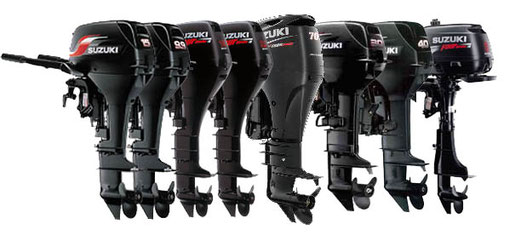
Boat motors, regardless of the power and number of cycles, are thoroughly tested and tested before implementation. The materials and components used are of the highest quality, so all
modifications are characterized by increased reliability and correspond to the stated characteristics.
- Two-stroke engines (DT) are presented in five versions with powers: 2.2; 9.9; 15; thirty; 40 horsepower. Suspended boat motors (PLM) of this type are convenient in terms of frequent
shipments, since they have a lightweight design. They are quickly gaining momentum, easy to manage and maintain. - Four-stroke engines (DF) are represented by a wide power range (from 2.5 to 300 horsepower). Moreover, the gradation occurs with an optimal pitch, which allows you to accurately select the
desired engine for the swimming facility.
All products can be divided into two groups according to engine power. The first (2-10 horsepower) are models for small boats, intended for amateur use. The second group, with an engine capacity
of 15-20 liters. forces already intended for pleasure craft of small capacity and yachts.
The second principle of division is associated with technical features and is based on the number of work cycles. Some engines operate on the principle of fuel intake — exhaust gases. Others
besides these also have intermediate cycles: compression and working stroke. Two-stroke engines are lighter, they are simpler in terms of design, maintenance and cheaper. Four stroke is an
example of excellence in technology. They are more economical, environmentally cleaner, have an increased efficiency, although they cost and are more expensive to maintain.

